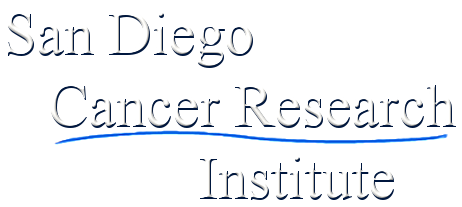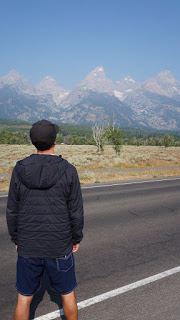On this page we have the Featured Articles from the years 2017 and 2018.
Enjoy!
Return to current Featured Articles here.
Featured Articles Archive 2014-2016
How a bench & a team of grandmothers can tackle depression by Rachel Nuwer, published on October 16th, 2018
Reaching the Summit of the Mountain In The Hallway by Tate MacDowell, posted here on October 25th, 2018
Mountain In The Hallway: Words & Artwork by Tate MacDowell, posted on September 28th, 2018
The High Cost of Cancer Treatment by Peter Moore, published June/July, 2018
Self Care Ideas and Resources by the SDCRI Family, posted on August 8th, 2018
The Power of The Emotional Freedom Techniques by Zariah Ricossa, LCSW, posted on July 3rd, 2018
Chemotherapy-Induced Peripheral Neuropathy: Ideas for Managing Symptoms by Cynthia Cooper, MFA, MA, OTR/L, CHT, posted on June 1st, 2018
Phoenix Rising Yoga for Cancer Recovery by Alessandra Colfi, PhD, posted on May 1st, 2018
Young Women Can and Do Get Breast Cancer by Amanda Nixon, posted on April 3rd, 2018
The V.I.P. of SDCC by Julie Shelton, posted on March 1st, 2018
Living with Cancer: Eight Things You Need to Know published by Scientific American
Cannabis as Medicine: Using medical marijuana in the oncology setting. by Teri Polley-Michea, posted on October 2nd, 2017
You Are Not Your Cancer by Dr. Paul Brenner, MD, PhD, posted on October 2nd, 2017
Fahnen fürs Leben • Hope Made Visible ™ • Banderas de Esperanza by Alessandra Colfi, PH.D. and Mary Hollander, RN/RMT, posted on August 1st, 2017
The Role of Chinese Medicine in Integrative Oncology by Kim Taylor, DAOM, L.Ac., posted on July 7th, 2017
Got chemo brain? by Teri Polley-Michea, posted on June 5th, 2017
Hacking Into Healing: The REAL Future of Medicine by Dr. Shamini Jain, posted on May 4th, 2017
Zumba: Gentle Dance Fitness for Cancer Recovery by Alessandra Colfi, posted on April 5th, 2017
Managing Side Effects of Stress, Cancer & Chronic Pain by Kitty Blincoe, posted on March 13th, 2017
The VITA Program by Jennifer Dawes Moore, posted on February 1st, 2017
SDCRI 2016 Yearly Review by Dan Vicario, MD, posted on January 12th, 2017
How a bench & a team of grandmothers can tackle depression
by Rachel Nuwer from Zimbabwe
The number of people that suffer from depression world wide is in the hundreds of millions. It is the leading cause of disability and the number of suicides per year is tragically so very high. In spite of this, the people who suffer from depression have very little options as far as psychological and medical help, especially in countries that don’t fall under the “First World” category. Some countries don’t even have a single Mental Health Practitioner within it’s borders.
So what can we do to save the lives of those who have fallen prey to this debilitating and amazingly common disorder?
One mental health program in Zimbabwe has the results to a program that just may be the solution, and the rest of the world is taking notice!
Go to the BBC article!
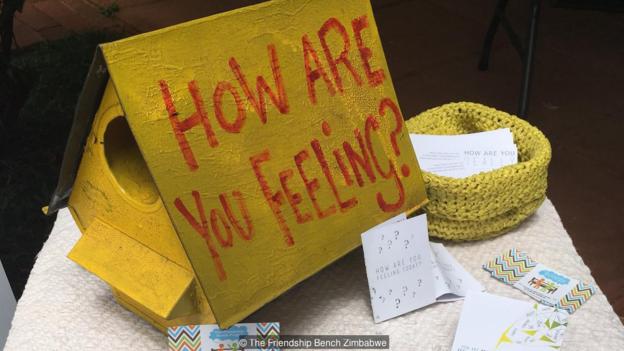
Back to the top.
Reaching the Summit of the Mountain In The Hallway
by Tate MacDowell
If you haven’t already watched the Mountain In The Hallway video and read Tate’s poem, you should do that first! It will make the reading of the reading of this blog so much sweeter!
See it in our previous feature, here.
Now continue the journey with Tate, as he looks toward completing his goal of climbing to the top of the Grand Teton mountains!
Read the Tate’s blog here, bringing you the this new chapter in his amazing life.
You can follow Tate’s blog at https://tatemacdowell.blogspot.com/
Back to the top.
Mountain In The Hallway: Words & Artwork By Tate MacDowell
published on August 1st, 2018 on tetongravity.com
For the vast majority of patients, a diagnosis of cancer can we very disheartening. Being diagnosed young can leave you with a terrifying sense of mortality and helplessness.
Two patients fought back against the fear, and rose to meet a challenge presented to them in the form of a photo hanging on the wall of the cancer center he attended.
This video is the initial story of Tate MacDowell and Brian McDonnell as they take on cancer and the Grand Teton Mountains, as well as artwork and poetry by Tate MacDowell sharing his thoughts and emotions on his journey.
Mountain In The Hallway: Words & Artwork By Tate MacDowell
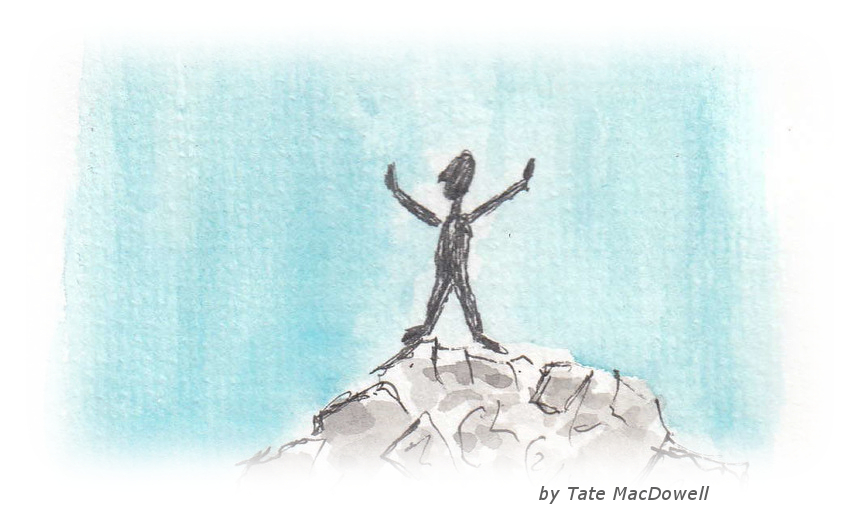
https://www.tetongravity.com/video/culture/mountain-in-the-hallway-words-artwork-by-tate-macdowell
Continue the journey with Tate here!
The High Cost of Cancer Treatment
by Peter Moore, AARP The Magazine
These days, there is a great deal of focus on the cost of living. Many of us worry about the inflation of the price of groceries and gas, or the ever increasing cost of electricity. These things could seem like a minor addition to an already sizable financial liability for a cancer patient dealing with the cost of treatment. The AARP has recently published an article regarding the “financial toxicity” of cancer treatment and how it can effect both the well-being and the quality of care for a patient. Article writer, Peter Moore, with AARP Magazine, shares the account of one patient and information that every cancer patient should know before starting treatment.
Read more here:
The High Cost of Cancer Treatment, by Peter Moore, AARP The Magazine
Back to the top.
Self Care Ideas and Resources
collected and presented by the SDCRI Family
What is self-care?
Defined by PsychCentral: What Self-Care Is — and What It Isn’t By Raphailia Michael, MA “Self-care is any activity that we do deliberately in order to take care of our mental, emotional, and physical health. Although it’s a simple concept in theory, it’s something we very often overlook. Good self-care is key to improved mood and reduced anxiety. It’s also key to a good relationship with oneself and others.” We also know that improving mood & reducing anxiety will stimulate your immune system.
We, at SDCRI, would like to share some simple self-care tips with you.
This is what we should all be doing every day.
- Eat a healthy, balanced diet. Mary’s Reality Based Nutrition
- Get enough sleep, 7-8 hours, each night. Nap during the day when needed. NPR: Sleep Scientist Warns Against Walking Through Life ‘In An Underslept State’
- Exercise every day. If all you can do is walk to the end of your driveway, then do that every day. When you are able to, walk the driveway twice a day. Slowly work up your endurance level. This will not only improve your health but it will also improve your mood & it is a good anxiety reliever. Harvard Health Publishing, Harvard School of Medicine: Exercise as part of cancer treatment, JUNE 13, 2018, By Monique Tello, MD, MPH
- Monitor your thoughts. Strive for a positive, grateful attitude. Set that intention
each morning as you start your day.
Nutrition Wow: Thought Detox
The Times of Israel: Israeli study finds positive emotions may shrink cancer tumors, By TOI STAFF, 13 July 2018
- Laugh! From the Chopra Center: 6 Reasons Why Laughter Is the Best Medicine
By Tamara Lechner
Pro-Active Self-Care information:
- Mindfulness and Meditation: There is so much more to meditation than just sitting quietly with your eyes closed (not that it isn’t a great way to start). Mindfulness are the practice of being present in the moment, in your life, in your thoughts and in meditation itself. Everyday Mindfulness is a great place to start learning how to be mindful.
- Tapas Acupressure Technique (TAT): This is a process that utilizes acupressure and a set of specific statements to help you ease spiritual, emotional and even physical troubles. In our very own archives we have a great article by TAT practitioner, Chris Lewis, with an explanation of the benefits of TAT.
TATlife.com has more explanation and break down of the technique, as well as videos, a list of practitioners near you, and an e-book you can purchase and practice with on your own. - Emotional Freedom Technique (EFT): EFT, also called “Tapping” is a technique that uses gentle, repetitive tapping your body’s median points to help you relieve stress, stimulate healing and help break out of negative patterns in your life. You can read about it in our previous article from Zariah Ricossa, then check out some of these videos found on YouTube:
Emotional Freedom Techniques (EFT) Demonstration
How to use EFT Tapping to Accelerate Healing
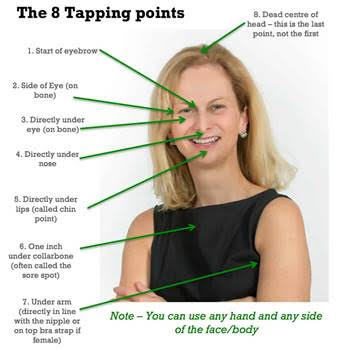
- Acupuncture: An ancient, key component in Chinese medicine, acupuncture has been proven by the World Health Organization (WHO) to effectively combat 28 different chemo-therapy related side-effects, as well as many other ailments. You can learn a lot about it through Kim Taylor’s article posted here just last year, or set up an appointment with one of our SDCRI Family Members (one of our vetted volunteers) listed on our Resource Page.
- Massage: Most everyone who hears the word “massage” automatically relates the idea to a spa treatment, an escape from the daily grind, or a moment of relief from their aches and pains. This goes double for cancer patients. Massage can not only help with stress and regular aches and pains, but it can help to lessen the terrible side effects of cancer as well. The SDCRI Family includes several Oncology Certified Massage Therapists, who will work with both cancer patients and non-cancer patients. Check out the Massage Therapist section on our Resource Page.
- Energy Work: Also called Reiki, Healing Touch and Laying-on-of-Hands, Energy Work could be considered a sort of “mind over matter”, though it is really more complicated than that. Whether you involve peaceful music, prayer, silence, or a relaxing conversation, Energy Work can have profound and even unexpected effects for both the patient and the healer. We have a list on our Resource page of Energy Workers who have worked with SDCRI. Connect with one and find out how Energy Work can help you!
Our Educational Videos page also has a few more ideas for you to enjoy. Have a look at the Complimentary Modalities section lower down on the page.
Check out more links on our Resource Page.
The Power of The Emotional Freedom Techniques -“EFT”- Tapping
Right at Your Fingertips
by Zariah Ricossa, LCSW
LIFE TRANSITIONING
After 30+ years of being a medical, Licensed Clinical Social Worker, both in hospital and Hospice work, it was time for me to make a professional shift… but what? Where? How? I had been in Private Practice but the thought of traditional insight psychotherapy did not inspire me.
How was I to integrate my love of being at the bedside in the sacred space of such intimate, end of life, mutual sharing? Wanting to offer an effective, profound, empowering means of assisting with healing, forgiveness, acceptance, honoring the richness of each person’s unique life?
Praying for guidance, I was re-exposed to EFT, Emotional Freedom Techniques, through The 9th Annual Tapping Solution World Summit… voila! I was on fire, feeling excited, and all my inner circuit lights turned on!
I WAS IN!! My mind/spirit knew that EFT could be the modality that would allow me to move forward in my own Private Practice.
WHAT IS THIS EFT STUFF?? FACT OR FAD?
The following is from: http://www.thetappingsolution.com
This website is loaded with hours of videos; guided meditations; children’s books, etc!
“What is Tapping?
“Tapping, also known as EFT (Emotional Freedom Techniques), is a powerful holistic healing technique that has been proven to effectively resolve a range of issues; stress, anxiety, phobias, emotional disorders, chronic pain, addiction, weight control, and limiting beliefs, to name a few.
Tapping therapy is based on the combined principles of ancient Chinese acupressure and modern psychology. Tapping with the fingertips on specific meridian endpoints of the body while focusing on negative emotions or physical sensations. This helps to calm the nervous system, rewire the brain to respond in healthier ways, and restore the body’s balance of energy.”
“So How Does It All Work?
“Tapping makes full use of the mind-body connection, acknowledging and integrating the concepts that physical pain, disease, and mental wellbeing are intricately connected to our emotional states.
The body is equipped with an energy system that travels along pathways known as meridians. Tapping on these meridian endpoints helps to stimulate this system. When verbally or mentally addressing the root causes of distress, the areas of blocked energy are able to release and flow naturally.
The basic Tapping technique requires you to focus on the negative emotion at hand – a fear, a worry, a bad memory, an unresolved problem, or anything that’s bothering you. While maintaining your mental focus on this issue, you use your fingertips to tap 5-7 times on each of the 9 specific meridian points of the body.
Tapping on these meridian points in sequence while concentrating on the negative emotions engages both the brain’s limbic system and the body’s energy system, encouraging a sense of safety and resolution. As the scientific field of epigenetics is proving, when you change your internal environment – your emotions and beliefs – external changes in your mental and physical health will follow.
In some ways, Tapping is similar to acupuncture. Like Tapping, acupuncture achieves healing through stimulating the body’s meridians and energy flow. However, unlike Tapping, acupuncture involves needles! “No needles” is definitely one of the advantages of Tapping!
Tapping is simple and painless. It can be learned by anyone, and you can apply it to yourself whenever you want, wherever you are. It can be used with a specific emotional intent towards your own unique life challenges and experiences. Most importantly, Tapping gives you the power to heal yourself, putting control over your destiny back into your own hands.”
Another great resource is by Dawson Church, PhD: https://www.eftuniverse.com
This site offers a free downloadable 60 pg. EFT mini-manual. EFT Universe also trains/certifies EFT practitioners for the use of clinical EFT.
Dawson is the psychologist researcher connected with over 100 clinical studies and his website contains over 5,000 stories written by people who have recovered from a wide variety of physical and psychological challenges using EFT. This anecdotal evidence is consistent with rigorous scientific research showing that EFT is an “evidence-based” method.
Studies show that EFT is effective as a self-help tool. It is also used in many healthcare settings by medical and mental health professionals. Both the VA and Kaiser have been doing their own EFT research with positive results and acceptance.
WHAT ABOUT EFT & CANCER PATIENTS?
I would like to highlight Kris Carr who at age 31 was diagnosed with a stage 4 incurable cancer with slow growing tumors. She took the bull by the horns, got in the saddle, and 12 years later is still living with and thriving through her chronic illness! You may know of her through her series of Crazy Sexy books. She has appeared on the Oprah Soul Series and countless other interviews.
For this year’s 2018 World Tapping Summit, Kris was interviewed by Jessica Ortner. Kris shared vulnerably, genuinely, humorously, and wisely how she stayed in the saddle through all of the rough rides over the years. From her initial diagnosis terror, waiting for scan results, and learning a new normal in her transformed life.
Tapping Solutions has granted permission for me to share with our SDCRI readers her workbook which includes a guided tapping round… don’t miss this!
WHAT ABOUT AN 81 YR. YOUNG LOCAL CANCER STAR?
For almost 3 months now I’ve had the privilege of getting to know “Goldie” a stage 4 cancer woman, who’s living with an unknown prognosis. Goldie had the wisdom to know that she needed counseling. When I asked her what her goal was in our work, she answered with a most remarkably succinct profound answer, “Release”!
It wasn’t until session 3 that she seemed ready for Tapping, of which she knew nothing. She dove in deeply from the very start. She was very sensitive/responsive to energy work. On the day of our 5th session, she uncomfortably stated there was something she wanted to work on that she’d never shared with anyone.
For the next 20-30 minutes she painfully covered her face as she recounted a very painful, shameful incident from when she was 10 yrs. of age. An incident which affected her relationship with her parents and haunted her for the rest of her years.
When Goldie finished her story, she was able to lower her hands and was willing to tap on the incident which she rated as a 10. After about 10 minutes of tapping, she was exhausted from releasing so much and her rating was down to a 4.
Our next session only one week later, I asked how she was doing with this incident?
Goldie looked quizzical, trying to scan her memory, and said; “I’m fine with it all.”
I asked how she would rate the intensity of this memory today and she gave it a zero!!
After energetically carrying this alone within the cells of her body for 71 yrs, it is now completely gone with no emotional charge remaining! Goldie, however, was unable to realize how profound this release was because she couldn’t access nor remember the prior intensity. This is a typical reaction after the intensity level has been totally cleared to zero!
I now keep reminding Goldie that the Life Force energy in her body, which was repressing old traumas, is now available for replenishing her immune system and healing of body/mind/spirit
MY PERSONAL CONCLUSIONS
There is a massive awakening of consciousness across our Mother Earth and we are being flooded with a plethora of countless methods of healing, spiritual paths, diets, etc… all available from our own computers…
Personally, I am thrilled with the Gift of EFT/Tapping and the quick and profound results I’m experiencing both with my clients and myself. I love the fact that EFT is empowering and can be used immediately by anyone. However, there is also a need at times for certified EFT Practitioners and Psychotherapists with EFT training to assist with initial, deeper issues to get to the bottom of both releasing the blocked energies in the body and their underlying limiting beliefs.
I look forward to how my Life experiences, my clients, and the limitless power of EFT/Tapping will continue to lead me and our world forward in living lives of more and more Emotional Freedom.
Chemotherapy-Induced Peripheral Neuropathy: Ideas for Managing Symptoms
by Cynthia Cooper, MFA, MA, OTR/L, CHT
Background
Chemotherapy-induced peripheral neuropathy (CIPN) occurs as a consequence of damage to nerves that may be caused by chemotherapeutic agents. It usually presents as numbness or tingling, but it can also present as pain that tends to be aggravated by exposure to cold.
CIPN has a significant effect on quality of life. Simple daily tasks can be impacted, such as fastening buttons or managing clasps on jewelry. Additionally, balance may be affected, which can compromise a person’s safety.
Sometimes the symptoms may persist even after completing chemotherapy treatment. It is reported in the literature that CIPN affects 30-to-40 percent of people receiving chemotherapy, but this is probably a low estimate. Some authorities suggest the actual incidence is more like 70 percent and is expected to grow. It is known that CIPN tends to be worse in people who have had nerve problems prior to receiving chemotherapy.
Our peripheral nerves are comprised of a variety of different nerve fibers, some of which transmit signals regarding sensation (sensory nerves) and some of which transmit signals regarding movement (motor nerves). These fibers differ in their resistance to the potentially toxic effects of some chemotherapy drugs. Longer nerves are more vulnerable, which explains why symptoms may start in the toes before occurring in the fingers. Among the different nerve fibers, the sensory fibers are more vulnerable than the motor fibers. This explains why the symptoms that people describe are usually more likely to impact their sensory function rather than their muscle function.
Managing Symptoms: Easy and Pleasant Movement
In the field of sensory rehabilitation, there is high-quality research about ways to promote function of impaired nerves. The concepts studied have confirmed that sensory perception is a dynamic process that is affected by stimulation. Nerves need oxygen, blood flow, nourishment, movement, and stimulation in order to function well. Disuse (such as occurs with sensory impairment) contributes to the problem because sensory receptors need stimulation in order to continue functioning well. The phrase “use it or lose it” describes the dilemma well. When we do not move a lot, there is a pooling of fluid between cells that can impair sensory function. This is true even though we don’t look swollen. Deep breathing and movement help minimize this pooling of fluid.
Deep breathing is an excellent way to begin. Breathing that is coordinated with gentle exercise is beneficial to the nerves. Gentle, pain-free, pleasant movements of arms and legs provide healthy stimulation. Examples include reaching overhead, rolling the shoulders in circular motions backwards comfortably, rolling a ball on a table or wall, fluttering your fingers in the air, marching in place, and wiggling your ankles and toes. Even an activity such as shaking a bottle of salad dressing is good “exercise” and stimulates particular sensory receptors in a beneficial way.
There are many other ways for people to promote sensory rehabilitation. More ideas will be presented in future articles. For starters, begin to think about your sensation. Try to identify where it feels normal and where the change occurs. Even this mental awareness is shown to favorably affect our sensory function.
A loving reminder from SDCRI:
Take a deep breath and smile to yourself.
Even a half smile can brighten up your day.
Phoenix Rising Yoga for Cancer Recovery
by Alessandra Colfi, PhD
Find a quiet, comfortable place to sit, with a fragrant cup of tea or a glass of water next to you…let’s breathe and relax together for a moment… inhale…..exhale….; inhale, 2, 3, 4; exhale, 2, 3, 4; pause, 2, 3, 4… let’s repeat this relaxing breathing ‘triangle’: inhale, 2, 3, 4; exhale, 2, 3, 4; pause, 2, 3, 4…
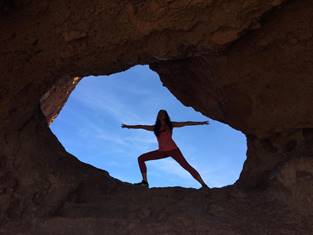
We can describe ‘Yoga’ or ‘Meditation’ in great details, but the actual practice is what makes a difference; so join me in bringing this practice into everyday life…OM…
 When I learned about a specific, focused Yoga training for cancer recovery by the local non-profit Be Well Therapy, I felt immediately drawn to it, as it would provide knowledge and awareness for me to be a better practitioner assisting cancer patients in my Expressive Arts Therapy program and engaging them with movement in my fun but gentler version of Zumba. Be Well is a very rigorous, comprehensive, and grounded Yoga for Cancer Recovery training, offered by Mary Baker and Heidi Borsch, extremely dedicated and experienced co-founders of Be Well Therapy. My work with cancer patients, combined with my own yoga experience, foundational anatomy and physiology, understanding key systems in the body, what is known about cancer, the interconnectedness of body/mind/spirit, breathwork, specific modifications of poses, use of supportive props, has resulted in an expansion of my practice to benefit our very special patients.
When I learned about a specific, focused Yoga training for cancer recovery by the local non-profit Be Well Therapy, I felt immediately drawn to it, as it would provide knowledge and awareness for me to be a better practitioner assisting cancer patients in my Expressive Arts Therapy program and engaging them with movement in my fun but gentler version of Zumba. Be Well is a very rigorous, comprehensive, and grounded Yoga for Cancer Recovery training, offered by Mary Baker and Heidi Borsch, extremely dedicated and experienced co-founders of Be Well Therapy. My work with cancer patients, combined with my own yoga experience, foundational anatomy and physiology, understanding key systems in the body, what is known about cancer, the interconnectedness of body/mind/spirit, breathwork, specific modifications of poses, use of supportive props, has resulted in an expansion of my practice to benefit our very special patients.
‘Because suffering is impermanent, that is why we can transform it. Because happiness is impermanent, that is why we have to nourish it.’ – Thich Nhat Hanh, 2014.
Several interrelated aspects of health and resiliency come into play during an individual’s cancer experience. Stress, inflammation, treatments with drugs and radiation, decreased energy, and inactivity create a complex cocktail with numerous unwelcomed side effects and complex ramifications.
Yoga as a union of body and mind facilitates relaxation, meditation, energy flow, and supports the immune system, thus enhancing mind-body health and resilience.
How Stress Affects our Health and Perception of Wellbeing
Stress is thought to affect immune function through emotional and/or behavioral manifestations such as anxiety, fear, tension, anger and sadness, as well as physiological changes such as heart rate, blood pressure, and sweating. Researchers have suggested that these changes are beneficial and necessary if they are of limited duration, but when stress persists and becomes chronic, the system is unable to maintain equilibrium or homeostasis, and the body becomes vulnerable.
Well-established research in psychoneuroimmunology has supported the relationship between emotions and health. ‘The term Psychoneuroimmunology was first introduced by Robert Ader during his presidential lecture to the American Psychosomatic Society in 1980. In that lecture he summarized research that demonstrates the fundamental unity of the bodily systems that function to maintain health, and he underscored the fact that the immune system is no exception to this general rule’ (Daruna, 2012).
“Psychoneuroimmunology (PNI) is the study of the interaction between psychological processes and the nervous and immune systems of the human body” (Irwin and Vedhara, 2005). ‘PNI takes an interdisciplinary approach incorporating psychology, neuroscience, immunology, physiology, pharmacology, molecular biology, psychiatry, behavioral medicine, infectious diseases, endocrinology, and rheumatology’ (Pestonjee and Pandey, Eds., p. 270). D.M. Pestonjee and Satish Pandey offer a sharp overview in Stress and Work: Perspectives on Understanding and Managing Stress: ‘The main interests of PNI are the interactions between the nervous and immune systems and the relationships between mental processes and health. PNI also studies the physiological functioning of the neuroimmune system in health and disease; disorders of the neuroimmune system (auto-immune diseases; hypersensitivities; immune deficiency); and the physical, chemical and physiological characteristics of the components of the neuroimmune system in vitro, in situ, and in vivo’ (Pestonjee and Pandey, Eds., p. 270). ‘Contemporary researches on health issues have proved that health changes are the consequences of immune modulation by psychosocial stressors and interventions. The stress-and-illness link further supports the importance of immunological deregulation and increased risks with respect to diverse conditions and diseases. It is also evident that social, emotional, and psychological disorders are related to stress’ (Pestonjee and Pandey, Eds., p. 270). ‘PNI research is looking for the exact mechanisms through which specific brain-immunity effects are achieved. Evidence for nervous system–immune system interactions exists at several biological levels’ (Ross, 2013, p. 147). “The immune system and the brain talk to each other through signaling pathways” (Watkins, 1997).
‘The brain and the immune system are the two major adaptive systems of the body. … Two major pathways are involved in this cross-talk: the Hypothalamic-pituitary-adrenal axis (HPA axis) and the Sympathetic Nervous System (SNS).
The body’s primary stress management system is the HPA axis, with the breath activating the Parasympathetic Nervous System. The HPA axis responds to physical and mental challenges to maintain homeostasis in part by controlling the body’s cortisol level. Dysregulation of the HPA axis is implicated in numerous stress-related diseases and is connected to increased inflammation.
Stressors can produce profound health consequences. Theorists propose that stressful events trigger cognitive and affective responses which, in turn, induce sympathetic nervous system and endocrine changes, and these ultimately impair immune function. Potential health consequences are broad, but include rates of infection, HIV progression and cancer incidence and progression.
Yoga works through breath, gentle movements and awareness, resulting in settling down the nervous system taking it from ‘fight or flight’ mode (Sympathetic Nervous System) to ‘rest and restore’ mode (Parasympathetic Nervous System), which helps reduce anxiety and pain.
A new research article published in Frontiers in Human Neuroscience investigates the effects of yoga and meditation on people by looking at physiological and immunological markers of stress and inflammation. By studying the participants of an intensive three-month yoga and meditation retreat, the researchers found that the practices positively impacted physiological and immunological markers of stress and inflammation, and in addition improved subjective wellbeing and Quality of Life.
The researchers monitored psychometric measures, brain derived neurotrophic factor (BDNF), circadian salivary cortisol levels, as well as pro- and anti-inflammatory cytokines. They also collected data on psychometric variables including mindfulness, absorption, depression and anxiety, and investigated the relationship between psychological improvements and biological changes.
Resilience
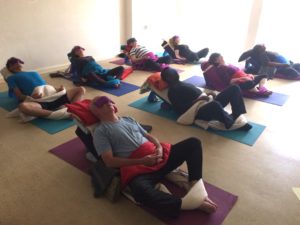
“Resilience is the capacity to deal successfully with the obstacles in the road that
confronts us while maintaining a straight and true path towards life’s goals”. – Robert Brooks and Sam Goldstein, 2003
Resilience in defined in psychology as the positive capacity of people to cope with stress and adversity. Coping may result in the individual bouncing back to a previous state of normal functioning or using the experience of exposure to adversity to produce a steeling effect and function better than expected (Masten, 2009). Resilience is most commonly understood as a process and not a trait of an individual (Rutter, 2008).
A very important aspect of resilience is the role of psychological energy and its redistribution: ‘…When an individual has to take on a burden such as a tragedy, what normally happens is that the person ceases participating in non-priorities and reallocates energy in order to handle the burden. The redistribution of psychic energy is important to the balance of the psyche’ (Furth, 2002).
Resilient patients differ from those who experience depression or more anxiety when they have been practicing relaxation and having ways to express themselves, cultivating their spirituality, supportive social networks, optimism and an attitude towards acceptance of adversities.
A recent study Psychosocial Adjustment Among Cancer Survivors: Findings from a National Survey of Health and Well-being examined whether cancer survivors showed impairment, resilience, or growth responses relative to a socio-demographically matched sample in four domains: mental health and mood, psychological well-being, social well-being, and spirituality. The impact of aging on psychosocial adjustment was also investigated. (Costanzo, Ryff, & Singer, 2009)
Findings indicated that cancer survivors demonstrated impairment relative to the comparison group in mental health, mood, and some aspects of psychological well-being. Longitudinal analyses spanning pre- and post-diagnosis clarified that while mental health declined after a cancer diagnosis, poorer functioning in other domains existed prior to diagnosis. However, survivors exhibited resilient social well-being, spirituality, and personal growth. Moreover, age appeared to confer resiliency; older survivors were more likely than younger adults to show psychosocial functioning equivalent to their peers.
The constant reminder though affects survivors’ psychological balance, confidence, Quality of Life, and resilience. Inflammation affects mood and increases likelihood of depression. More than ever survivors benefit from practices like Mindfulness, Yoga, Dance/Movement Therapy, Expressive Arts Therapy, nutrition, social connections, etc.
Resilience has more to do with self-transformation than with survival. It’s the combination of attentiveness, insight, and choice that lets some people tune in to the hidden energy lurking within a crisis and use it as a catalyst for spiritual growth. Though psychologists can list the qualities that resilient people have in common—insight, empathy, humor, creativity, flexibility, the ability to calm and focus the mind—this deeper resilience transcends personality traits.
Jungian psychologist and Buddhist meditator Polly Young-Eisenstadt discusses the matter elegantly in a book called The Resilient Spirit. She points out that we become truly resilient when we commit ourselves to dealing with pain—inevitable and unavoidable —without getting caught in suffering—the state in which our fear of pain and our desire to avoid it close us off to the possibilities inherent in every situation. This, of course, is the art that yoga is meant to teach us. …few of us know how to process the pain of loss or failure without getting hooked by our suffering.
PTSD can also develop from a cancer diagnosis and the emotional and physical pain of invasive procedures, frightening information and clinical environments. Yoga invites patients to be proactive in their own healing, connect with others in the local community, and leave each class with a renowned appreciation for their bodies and a sense of hope.
The YMCA reports that practicing yoga during cancer treatment can help reduce symptoms of fatigue and pain. Cancer patients who have participated in yoga exercises have reported less sensitivity to pain of symptoms from treatments compared to those who do not participate. Yoga can help strengthen core muscles and improve blood flow which can help lower blood pressure and heart rate. In addition to improving physical symptoms, yoga can help alleviate depression and anxiety associated with treatments.
Interstitium: the newly-discovered organ under the skin, also known as Fascia or Connective Tissue
A very important physiological aspect of Yoga practice for cancer recovery is the awareness and consideration for maintaining a healthy, supple fascia. The fascia is a thin lining of fibrous tissue covering the entire body under the skin, enclosing all muscles, tendons, organs.
One can imagine the body being wrapped entirely in plastic wrap. By giving a tug to one part of the wrap, it will tighten elsewhere. If tugged hard enough, the wrap could tear anywhere there is enough tension placed upon it. The body has a system like this in place — only it’s on the inside where we can’t see.
Fascia is internal connective tissue that wraps around organs, providing support and holding parts together. It has the appearance of a very thin spider web, connecting layers of muscle and surrounding all internal body tissues.
A normal, healthy fascia is somewhat relaxed and wavy; the elasticity of fascia is due to many interlocking collagen fibers, or strands of proteins that act like coiled springs: strong, but stretchy. This allows the fascia to be responsive and flexible.
Among the side effects of chemotherapy, hormone therapy, radiation, and surgeries on Fascia is decreased flexibility, challenged balance, scar tissue build-up, and Myofascial Pain Dysfunction Syndrome, characterized by trigger points in a muscle or at the junction of a muscle and fascia, which refers pain to other areas of the body, and which is associated with breast, abdomen, and head and neck surgery in cancer survivors. What is the antidote? Movement and hydration, for improved balance, coordination and overall functioning of the musculoskeletal system. In Yoga for example, one can isolate a specific muscle, then mindfully focus and contract that muscle; then slowly release the same muscle until back to neutral; practice and increase range of motion, in and out of stretch. Or use gravity in safe supported inversions and gentle twists to facilitate detoxification.
Dr. Helene Langevin explains the importance of connective tissue in the body and its link to the immune system. She shares about recent findings on the beneficial effects of stretching to reduce inflammation and fibrosis, and the relevance of these findings to understand chronic pain and cancer. A negative feedback loop occurs where pain stiffens the fascia and the patients tends to move less because of the pain and fear of further damage, thus increasing stiffness and decreasing mobility, lubrication, and increasing inflammation, which becomes chronic. Langevin observed that cancer cells live and reproduce when attached to an unhealthy Fascia, where inflammation is like a crisis response to keep feeding cancer cells; by stretching and lubricating the Fascia, besides muscles and joints, inflammation diminishes, and the fascia becomes a less desirable host of cancer cells.
The implications of the research are fascinating… pathologist Neil Theise suggests that the Interstitium could be a fundamental force in driving cancer metastasis and offers a biological explanation for the reported efficacy of techniques such as Acupuncture, Yoga and massage. This new information fits what we know about fascia and how connective tissue needs to be stretched to make it harder for tumors to embed themselves and grow (Theise, 2018).
Each patient is my exceptional teacher; during a group Expressive Arts session, the image of the Phoenix emerged, and its symbolism was explored and represented by several patients. The Phoenix is a mythological figure which symbolizes heroic rebirth, renewed strength, vitality, and power – present in each person and supported by the community – to rise through and above traumatic and extremely challenging circumstances.
Yoga for Cancer Recovery supports individuals’ wholeness and resilience to be re-born and soar through a life-altering journey like cancer diagnosis, treatments, surgeries, with their physical, mental, and emotional toll, and offers practical tools and gentle guidance to meet the unique needs of people affected by cancer. Yoga is known to reduce fatigue and stress (cortisol levels), calm the mind, ease pain, alleviate depression, and improve overall Quality of Life.
My gratitude to my Be Well teachers and my fellow graduates for each one is making a difference in patients’ lives; to all patients, families, clinicians I have the honor to walk along.
Join me in an invigorating breathing ‘triangle’:
Together… inhale, 2, 3, 4; pause, 2, 3, 4… exhale 2, 3, 4;
again: inhale, 2, 3, 4; pause, 2, 3, 4… exhale, 2, 3, 4;
inhale….exhale vocalizing OM…
Lokah…Samastah…Sukhino…Bhavantu…
‘May all beings everywhere be happy and free, and may the thoughts, words and actions of my own life contribute in some way to that happiness and to that freedom for all.’
Namaste.
References:
Costanzo, E. S., Ryff, C. D., and Singer, B. H. (2009). Psychosocial Adjustment Among Cancer Survivors: Findings From a National Survey of Health and Well-Being. Health Psychol. 2009 Mar; 28(2): 147–156. Retrieved in https://www.ncbi.nlm.nih.gov/pmc/articles/PMC2668871/
B. Rael Cahn, Matthew S. Goodman, Christine T. Peterson, Raj Maturi, Paul J. Mills. (2017). Yoga and meditation improve mind-body health and stress resilience: New research finds that practicing yoga and meditation has positive effects on mind-body health and stress resilience. Frontiers in Human Neuroscience, 2017; 11. Retrieved in www.sciencedaily.com/releases/2017/08/170822104855.htm
Langevin, H. (2016). Stretching, Connective Tissue, Chronic Pain, and Cancer – 2016 Kanbar Lecture on Innovations in Integrative Medicine. Retrieved in https://www.ucsd.tv/search-details.aspx?showID=30714
Theise, N. (2018). Retrieved in https://nyulangone.org/press-releases/researchers-find-new-organ-missed-by-gold-standard-methods-for-visualizing-anatomy-disease
A note about Be Well Yoga for Cancer Recovery Program
This program was developed to assist those living with cancer – from the first moment of diagnosis continuing throughout the entire recovery process.
Be Well Yoga for Cancer Recovery Program is a specialized yoga methodology that is tailored to address the specific physical and emotional needs left by cancer and its treatments. This is not just another “gentle” or “restorative” yoga class. Our classes help students regain strength and mobility after surgery, support a healthy immune system, protect and strengthen bones and joint that may be weak from treatments, and reduce stress. We also take into account the many possible limitations and side effects that cancer, surgeries, and cancer treatment can cause, and the practice is modified based on the individual needs of the student with safety being our number one priority. Be Well Yoga for Cancer Recovery Program includes Yoga poses linked together in a mindful, safe format; Breathing techniques; Guided imagery; Meditation practice; Deep relaxation; Group support.
* Free Group Gentle Yoga Classes are offered Tuesdays, 5.30 pm to 6.30 pm with North County Cancer Fitness – NCCF in Oceanside. Complete intake process required prior to attending NCCF classes. Here is the link to start the process: https://northcountycancerfitness.org/consultation-intake/
* Individual sessions available. Call Alessandra at 858 735 5708 to ask questions, to schedule an appointment and for rates.
Young Women Can and Do Get Breast Cancer
by Amanda Nixon
Young Survival Coalition (YSC) is the premier organization dedicated to the critical issues unique to young women who are diagnosed with breast cancer. YSC offers resources, connections and outreach so women feel supported, empowered and hopeful.
Celebrating 20 years, YSC was founded in 1998 by three women who were under the age of 35 when diagnosed. They were discouraged by the lack of resources available and the under- representation of young women in breast cancer research.
Today, we provide information and resources for young women during every phase of treatment and survivorship through our comprehensive Navigator guidebooks and audio/video library. Navigators and ResourceLink guidebooks can be downloaded electronically; or, hard-copy versions can be ordered and shipped free of charge to healthcare practitioners and patients at any time.
The Newly Diagnosed Navigator (also available in Spanish) helps young women learn to navigate their journey with information about breast cancer diagnosis and treatment, an easy-to-understand breast cancer glossary, questions to ask their healthcare team and inspiring messages from young women who have been down this road.
The Metastatic Navigator helps young women understand the complexities of living with stage IV breast cancer and educates about treatment options. This navigator provides advice on working with healthcare teams, and includes forms and tools to help young women stay organized.
The Post-Treatment Navigator tackles the post-treatment phase with a survivorship care plan to use with a healthcare team. This navigator provides practical tips for addressing sex and intimacy concerns, family planning options and long-term side effects like “chemo brain” and lymphedema.
The Long-Term Navigator addresses how to manage long-term side effects and move forward with life after diagnosis and treatment.
View/ order here: https://www.youngsurvival.org/learn/resources-and-tools/educational-materials
We offer support and education programs created just for young women with metastatic breast cancer to help them make informed decisions, live well and build a supportive community.
Additionally, our local Face 2 Face (F2F) meetups, one-on-one peer support program, vibrant Discussions Boards and online video support groups help young women connect no matter where they are. F2F networks are grassroots support and social networks that bring together young women at all stages of a breast cancer diagnosis, treatment or recovery to support, empower and learn from each other. San Diego has a robust F2F network, hosting support groups and events near La Jolla, Carlsbad, South Bay, East County and a co-survivor meetup in Temecula.
Locate the nearest F2F: https://www.youngsurvival.org/meet-in-person
YSC also offers peer matching. Our trained SurvivorLink peer mentors are young women from all backgrounds and volunteer as empathetic listeners. We have mentors who:
-
-
- were diagnosed in their early 20s
- are partnered with other women
- have had chemotherapy while pregnant
- live with metastatic disease
- are estrogen receptor +/- or HER2+
- have had a double mastectomy or an oophorectomy
- are triple negative
-
If telephone or email support is desired: https://www.youngsurvival.org/talk-one-on-one
Another option might be our facilitated online video support groups. They are a safe place to share feelings, experiences, information and resources, all from the comfort of your home. Three different groups allow young women to join one that meets their needs:
-
-
- Women in treatment
- Women under 30
- Women with metastatic breast cancer
-
To participate by video you need to have a computer, tablet or phone with a webcam and internet/data connection. There is a separate phone line provided for the audio portion. If you are not able to connect with video, you can join in by phone only.
https://www.youngsurvival.org/connect/find-support-online/online-video-support-groups
YSC’s annual national Summit and Regional Symposia are the only conferences dedicated to the unique needs of young women with breast cancer. Attendees get cutting-edge medical information and leave with lifelong friends. Healthcare professionals can earn CEU’s and are invited to learn more about young women with breast cancer.
https://summit.youngsurvival.org/
Young women can and do get breast cancer. Please share Young Survival Coalition with your colleagues, patients, and friends to ensure no young woman faces this disease alone. For more information or questions about YSC email anixon@youngsurvival.org
Amanda Nixon
West Regional Outreach Manager
Young Survival Coalition
The V.I.P. of SDCC
by Julie Shelton
On December 7th, 2017 a very important person was honored at the UC San Diego Cancer Center in Encinitas. After a few weeks of preparation and a lot of coordination, a merry “ambush” was set for the target.
Dr. Paul Brenner came in for his usual visit and was surprised by the nurses and staff with a big basket full of sweets and a gaggle of cards from all of his admirers. Each card was a personally created “love note” from staff members that have been privileged to work with Dr. Brenner the in past. Well wishes, expressions of gratitude and adoration, and recollections of fond memories were handwritten and bundled up in the basket for Dr. Brenner’s viewing pleasure.
 The sweets selection included -but was not limited to- a wide variety of chocolates (his favorite type of sweet). Two boxes of chocolates even had images of blueberry muffins and Nike shoes attached to them as exclusive inside jokes, meant just for Dr. Brenner. Both of those will be explained later in this article.
The sweets selection included -but was not limited to- a wide variety of chocolates (his favorite type of sweet). Two boxes of chocolates even had images of blueberry muffins and Nike shoes attached to them as exclusive inside jokes, meant just for Dr. Brenner. Both of those will be explained later in this article.
While I personally missed the event of the presentation, I did get the chance to interview Dr. Brenner about the experience and his feelings about it. “It was very emotional.” He told me quietly, while sitting in the waiting room, “First of all, it was all sadness when I got up here, because I missed this place so much. And then getting home and looking at each letter, just brought tears. It was the most loving thing ever. It was just really special.”
I spoke to Dr. Brenner’s previous Medical Assistant, Karen, who was a co-instigator and the presenter of this distinct award (dubbed the “V.I.P. Award”). I wanted to get an idea of what inspired this beautiful plan.
“My husband said it best when he called him Doc Adams from Gun Smoke,” Karen explained further. “In other words, Doc Adams would see anybody, treat anybody.”
Karen related the story of an episode of Gun Smoke in which Doc Adams is kidnapped by fugitives, and even though his own life is threatened, Doc Adams does not hesitate to save an injured member of the gang.
“That’s how Dr. Brenner was. He didn’t care what your insurance was, what your background was, what was going on in your life. He was always there to help you. He would do that with staff, he did that with family members of staff, he did it with patients, with patients’ family members,” Karen said with admiration. “He treated everybody equally.”
I asked Karen Lee about what lead to the V.I.P. award. “Lory and I were talking and I wanted to give [Dr. Brenner] an award like he was royalty. We’re supposed to treat all our patients the same, but I wanted him to know he was special. Because of what he had done in the past, and for who he is.” Karen explained, “Lory and I start brainstorming and she came up with the idea of ‘V.I.P.’”
Karen felt it was important that Dr. Brenner understood that the staff didn’t just see him as his diagnosis or his patient number. “I wanted him to know that he will always be a VIP. It was just kind of a way of acknowledging him for his past and what he is going through.”
Dr. Brenner’s has received other honors from various institutes, which include the Life Devotion Award received in Taiwan, The San Diego Enlightenment Award, and The University of California San Diego School of Medicine Physicians Teaching Award. He has also written multiple books, given a talk on TEDxWomen, and presented a series of interviews on KPBS called “Healing Through Communication”. With all of that, you would think that Dr. Brenner would be used to accolades, but he was as surprised and embarrassed as could be by the love.
Lory, the other conspirator in the creation of the V.I.P. award, shared her favorite memory of Dr. Brenner, “I like the fact that his is really blunt and honest.” Lory told the story about Dr. Brenner coming in to the office with a pillow and a newspaper. Lory had asked him if he was coming in to sleep, he told her that he’d fallen down and had ‘literally busted his ass’. She laugh at this, “He tells it like it is!”
Lory also recalled Dr. Brenner’s favorite pair of shoes, which were black Nike Cortez. She’d even attached a little image of those shoes on a box of chocolates which she had placed in the gift basket. You can hear Karen mention that and the muffins in the video below.
When I asked Dr. Brenner if he’d already eaten all of the chocolate, at first he told me he had eaten “very little of the chocolate” and was going through it slowly. After a short moment, he then confided with a delightful laugh, “All the little pieces are gone… and half the big pieces.”
Many members of the UCSD Cancer Center staff had been members of the original San Diego Cancer Center (SDCC) and the San Diego Cancer Research Institute (SDCRI), back when they were the primary tenants of the second floor in the Garden View Road location. As such, those staff members had the pleasure of getting to know Dr. Brenner, and watching him working with, and caring for his patients first hand. As he touched the lives of so many patients, he also inspired and supported the peers and employees that surrounded him.
I spent a few weeks rounding up as many testimonies as I could, regarding the opinions these staff members have about Dr. Brenner.
When asked what she loved most about Dr. Brenner as a doctor, Mary, SDCRI’s RN and Nutrition Guru, replied: “He says what he thinks, does not judge his patients, includes them in all decisions, encourages them to be the best they can be & does all this with integrity.” Mary had worked with Dr. Brenner through the San Diego Cancer Research institute for several years before she retired. “He really does love everyone unconditionally.”
I also asked Mary about her favorite aspect of Dr. Brenner as a person. Among several response she gave, she mention: “His wonderful sense of humor.”
I asked another Medical Assistant, Val, what she thought was Dr. Brenner’s strongest aspect as a person and as a doctor and she said: “He listens to you and understands what you’re trying to say even when you can’t form the correct words to explain it.”
This sentiment was shared by many more office members that had worked with him, as well as the mention of the Blueberry Muffins that he would often bring to the Vista office staff.
Apparently the muffins were a routine gift that he brought roughly twice a month, and each time he would give the muffins to a different group of people than had last received it. (i.e. the front desk, then billing, then the chemo bay nurses).
Monique, one of the Front Desk Coordinators, even commented that Dr. Brenner is “sweet as a blueberry muffin”, as a tribute to those cherished treats and the man who gifted them to everyone.
For over 50 years, Dr. Brenner has worked in the medical field. His titles have ranged through multiple specialties, including Obstetrics and Gynecology, Surgical Oncology, and Counseling Psychology, not to mention Director of Psychosocial Oncology and Support Group Coordinator at the San Diego Cancer Research Institute. As a Medical Doctor (M.D.) and Doctor of Philosophy (Ph.D.), Dr. Brenner has spent a good deal of time just researching “what makes an individual chronically ill or well.” As a cancer patient, himself, Dr. Brenner has gained more insight and understanding of what patients go through and is able to relate in ways that many doctors just cannot duplicate.
Jenn, a Front Desk Coordinator, didn’t hesitate when asked what word she thought of when she heard Dr. Brenner’s name: “Cool!” I asked if she wanted to elaborate on her choice and she was unwavering. “Nope!” She responded with her beautiful smile, “That is the first word that came to mind.”
With his charismatic, inviting personality, his calm demeanor, and his infectious passion for life, that one word can be applied to Dr. Brenner in multiple ways.
There were several words that kept coming up in the interviews with all of the people that had worked with Dr. Brenner. “Empathy.” “Kindness.” “Love.” “Honesty.” With those references resounding from all around the Cancer Center, it’s hard to ignore the fact that he is indeed a Very Important Person, not just to staff, but to his patients as well!
Dr. Daniel Vicario, a long time peer and close friend of Dr. Brenner’s, was of the same mind as most everyone else. “He is always totally present. He deeply cares about others.” Dr. Vicario went on to say, “[Dr. Brenner is] devoted to be of service to those in need. He wants to help patients get to the root cause of their ailments and pain.”
My own experience with Dr. Brenner has been a great blessing. His guidance and caring through a difficult time have been so very important to me, and I am truly grateful for his loving friendship.
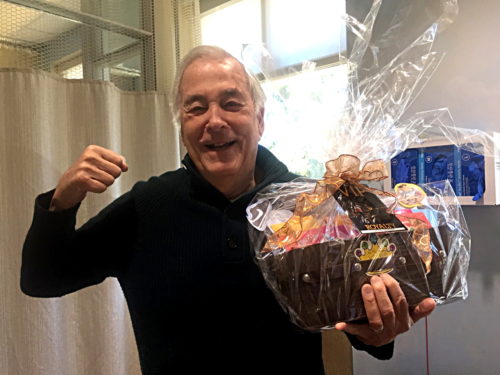 Even after the San Diego Cancer Center merged with UC San Diego, and after the San Diego Cancer Research Institute had to close its doors, Dr. Brenner has continued to offer his support, advice and boundless love to anyone that asks.
Even after the San Diego Cancer Center merged with UC San Diego, and after the San Diego Cancer Research Institute had to close its doors, Dr. Brenner has continued to offer his support, advice and boundless love to anyone that asks.
A great friend, a great doctor and a great man. Dr. Brenner encompasses the building blocks of a beautiful new world. May he be an example that is followed by incoming generations of doctors and people in general, so that our futures may be filled with compassion, acceptance and love.
Now, here is the brief, but sweet video of Dr. Brenner receiving his V.I.P. Award!
Living with Cancer: Eight Things You Need to Know
An article on the book by Kris Carr
This month we have a link to a special article about planning for and understanding your cancer. There so much more to cancer than just a diagnosis and medical treatments. Going along the lines of the old saying “Know your enemy”, it is important to learn as much as you can and check all of your options. Getting multiple opinions, ask the right questions, and living your life the way you want to are just some of the suggestions given by writer and “foot soldier” in the fight against cancer, Kris Carr. Explore more about Kris’ system and her personal experience, right now, on the Scientific American website:
https://www.scientificamerican.com/article/living-with-cancer-8-things/
Cannabis as Medicine: Using medical marijuana in the oncology setting.
By Teri Polley-Michea
As a cannabis nurse navigator it is my honor and privilege to help guide patients in making educated choices when selecting and using medical marijuana as part of their healing journey.
Early on in my life, I knew there were benefits to using cannabis to help curb the side effects of cancer treatment but was not sure why it was illegal.
My mother had breast cancer in the 1970’s. She had a radical mastectomy, all her lymph nodes removed on one side, she had chemotherapy and radiation. We lived in a small town in Iowa so she had to travel to the Mayo Clinic in Rochester, Minnesota for her care. It was grueling. She had all the common side effects, nausea, vomiting, fatigue, loss of appetite, diarrhea/constipation. It grew to be too much for her. At that time, her MD encouraged her to smoke pot. Even if it was illegal, he told her it would help get her through treatment by easing the side effects from her chemo that made her feel so bad.
Unfortunately she did not take his advice and she discontinued her treatment. She passed away at a very young age. Would she have survived? That we will never know but it left me wondering why was cannabis not readily available to patients who were suffering? People have used marijuana /cannabis for at least 3000 years or more for medical conditions. If cannabis has so many beneficial qualities why was it outlawed? How could the government keep this from us? How could one plant that is easily grown and has so many compounds that can address so many symptoms be illegal? It seems so inhumane! Was it all about money?
Did the lobbyist mis-inform the government on purpose to keep it from being used?
Why the change now? Just like Integrative Medicine, the public, including oncology patients and people with chronic diseases are contacting their legislators requesting changes in state and federal regulations. While cannabis remains a Schedule 1 drug federally, here in California and in many states across the US, Canada, and other countries, cannabis is legal for medical use and soon will be legal for recreational use. What does it mean to be classified as a Schedule 1 drug? In order for the government to limit the use of cannabis it was placed in the same category as heroin, LSD, Ecstasy, peyote and psychedelic mushrooms. Schedule 1 drugs are said to have a high potential for abuse, have no current acceptable medical use in the US, and lack accepted safety under medical supervision. OxyContin is not even listed as a Schedule 1 drug and look at the crisis that is occurring in today’s society. To date, no one has died from using medical cannabis correctly. There is less risk of becoming addicted than many of the medications prescribed by your MD but even they can not prescribe cannabis. There are doctors who have a special designation to give you a recommendation to get medical cannabis.
The medical cannabis that is being manufactured today is not your average ditch weed from the 1960’s. Medical grade cannabis is lab tested, most generally by a third party lab, to ensure it is free from molds and other contaminants. They do thorough testing and quality control.
The lab certifies its components.
Cannabis is a medication that can reduce pain and suffering, reduce nausea, decrease inflammation, decrease anxiety and depression, is a neuroprotectant, can improve neuropathy, just to name a few of the benefits. Cannabis, when dosed appropriately, can provide relief without the side effects of narcotics or other medications. It is possible to enhance healing without getting the high.
What about research you say? It is limited, as was the research using Integrative medicine modalities when first introduced to mainstream medicine. The difficulty lies within the system.
Since Cannabis is illegal federally there is limited funding available and there is still fear of loss of license or future funding if researching a federally illegal product. But I’m happy to report there is scientific research happening right now, and medical training programs for nurses, healthcare providers, and MD’s.
A study in J.Pain, 2013 Feb., 14,(2):136-148 by Wilsey, B., and all, looked at the use of low dose vaporized cannabis and how it improved neuropathic pain. Another study done in 1982 found on line at researchgate.net compared the use of oral THC and Compazine on chemo induced nausea and vomiting found that both medications had equally beneficial outcomes.
Online library.wiley.com published a review article written by Joan Kramer, originally published 12/10/2014, titled Medical marijuana for cancer. It discusses the use of cannabis in the oncology setting and reviews some of the current research done. Outcomes on pain, weight loss, poor appetite, nausea and vomiting were reviewed. The article pointed out there were benefits and encouraged more research to be done.
So, if you decide this is something you want to investigate, how do you go about doing it?
The process can be overwhelming if you are not feeling well. Don’t let the process get you down. There are educated professionals out there that can guide you.
First you have to get a recommendation from a Cannabis MD. (Remember, previously I wrote you can not get a prescription from your MD). After you had gotten your recommendation you can go to a dispensary. They are few and far between because most cities have either limited the number of dispensaries able to operate in the city or denied their request for a business license to operate. This forces patients to go on line and order based on what they read on a website or what family or friends recommend. Most dispensary staff are well trained on products and can help you make selections but they can not counsel you on your medications or health challenges unless they are medically trained because it would be out of their scope of practice. That’s where the nurse navigator comes in. We meet with you, look at your goals for treatment, look at your current health status and medications, we take a holistic approach, including lifestyle changes. Together we look at products and you decide what is right for you.
Product selection can be confusing. There are edibles, teas, tinctures, sprays, vaporization cartridges, flower buds for smoking, pre-rolls, waxes and topical preparations.
The onset of action and duration of action varies with each product. The dose varies depending on what product you purchase. There are CBD/THC blends are in a variety of concentrations, 18:1, 8:1, 1:1, some products are rich in THC (the psychoactive compound in cannabis), some have very little. Some products are better to take in the evening because of their sedating properties. There is not a one size fits all dose for each disease process. We suggest you start low and go slow. It is important to take an active role in your dosing. We use a flow sheet so you can see what works for you and make adjustments depending on your response.
We also encourage you to let your MD know you have chosen to try cannabis. Cannabis can affect the metabolism of some medications that are processed in the liver so it is important for your MD to be aware of that. Most MD’s support their patients’ choices. Insurance does not cover the cost of cannabis, it is an out of pocket expense.
We work directly with you and if you choose, your MD, to help your journey to wellness be the best it can be.
If you have any questions or want to know more about the Cannabis nurse navigators you can reach us at holisticcaring.com
Your Are Not Your Cancer
By Dr. Paul Brenner, MD, PhD
“ The mind is both a healer and a slayer”
Kenneth R. Pelletier M.D., PhD.
I have been a Physician for over fifty years. Presently, I am a Psychosocial Oncologist at the UCSD Health Systems San Diego Cancer Center, where I sit with my “patient-teachers” who have taught me about the nobility of what it means to be human. I have learned from patients about the healing power of love. They have taught me to accept life with all its beauty and with all its thorns. They have instilled in me that fear is the enemy of love.
And perhaps most importantly, love is the absence of fear.
We can never allow cancer to dominate or define who we are. Fear is a product of our mind. The mind informs the brain and the brain responds to fear’s threat. In turn, the brain produces chemicals that prepare the body to react to each given stress. This is called the “fight or fight” response. This intermittent response to an immediate fear is life saving, but if stress and fear become chronic, it can diminish the expression of the immune system.
The field of Epigenetics potentially offers individuals medical and non- medical therapies for the treatment of illness. Epigenetics is the study of those environmental forces that affect the expression of genes. This new field can also empower individuals to become more actively involved in their own healthcare by learning skills to control the mind’s emotional patterns. The mind’s gift is creation; it’s curse, self-destruction.
You are NOT responsible for creating your illness but are responsible for responding to it. I do believe that individuals with chronic illness can co- create with their physicians and their various therapeutic modalities by resolving, as best they can, the stresses and fears within their lives.
At the Cancer Center, I advise patients to observe their thoughts and control those that are negative, fearful or anxiety provoking. These thoughts are most often, “When is my next blood marker?” “When is my next PET or MRI?” “ “Am I going to make the wedding or see my grandchild?” etc. The mind tends to be filled with the future, obscuring the present moment.
Therefore, in learning skills to observe and change our thoughts, our beliefs and familial psychological patterns, we have the potential to alter our immune system and perhaps, even our inherited biology.
I have been living with cancer for fifteen years and observed how many of my thoughts were either unhealthy or focused on the future or past. One day, I realized my mind could not hold two thoughts simultaneously. I found that it helped me to devise skills to control thoughts.
Now, I advise patients to observe their mind. When a negative or redundant thought is perceived and continues to fill their consciousness, I tell them to simply repeat to themselves a single word. I personally use the word “Delete” over and over again for about ten seconds. This simple process can cancel negative thoughts for a prolonged period of time. Or, I tell patients to just clap their hands as a distraction. And finally, the one I most recently use for myself, ”I am love. That can’t be my thought.” I found that if I use this healing phrase my thought patterns are cleansed and I’m filled with calm.
As an Obstetrician, I believed that the newborn is not only a miracle, but also love made visible. This truth about all of us tends to be lost over time. We must reclaim that knowing, this wholeness. Love has no fear. Love holds peace. Love is our true nature. Love is our essence. We cannot allow anything to diminish who we are, not cancer, nor life’s experiences.
About Dr. Brenner
Back to the top.
Fahnen fürs Leben ~ Hope Made Visible ™ ~ Banderas de Esperanza
By Alessandra Colfi, PH.D. and Mary Hollander, RN/RMT
Gabriel Heyd & Alessandra Colfi, the founder of SDCRI’s Hope Made Visible™ project, met at the beach in Oceanside in 2013. Alessandra told Gabriel about her new project:
“Through social media and networking, we are starting to receive flags from all corners of the world. Every time we receive a box with magnificent, unique flags with their heartfelt messages, patients feel connected, moved, and hopeful.
“Prayer Flags have been used throughout history, in different cultures and traditions, as a symbolic means to promote peace, compassion, strength and wisdom. They are hung outdoors where the wind passes through the flags carrying the message and blessings to all people … words and symbols dissolving into the wind and being spread to all whom the wind touches. Our Prayer Flags are a living, breathing, kinetic journal of our hopes, dreams and concerns; wishes and good thoughts are blown by the wind, spreading good will and compassion, uplifting all beings. The silent prayers are blessings spoken on the breath of nature! Participants are invited to design several unique flags with fabric, paper, and other materials, as a reflection of their current hopes and dreams, giving a visual voice to your prayers, blessings, concerns, and thoughts… Imagination unleashed!” ~Alessandra Colfi
Gabriele loved the idea & decided to become a part of it in her country, Germany. When Gabriele returned home to Tübingen, she founded Fahnen fürs Leben, (this site can be translated into English). As Alessandra had done, Gabriele reached out to anyone touched by cancer, their friends & families. She also found like-minded Expressive Art Therapists to run the groups. When the program took hold in her community she held their first exhibition ~ see the list below. As news spread to other European countries through the efforts of both Alessandra & Gabriele, new groups were formed.
In a booklet that Gabriele has published, she states that her aim is to create small flags that are filled with hope & wishes. “This is about a worldwide network of people who are – directly or indirectly – affected by cancer. It‘s about courage, hope and solidarity. Everybody can join in. No matter whether she or he merely thinks of cancer as something unpleasant, whether he or she is a therapist, relative, friend, or affected by cancer.”
The preface: “Some flags are truly small master pieces, while others touch us with their simple design. With a flag it is possible to touch on the subject of cancer or to work on it in depth. It is good to know that Joseph Beuys (German artist 1921-1986) considered every single person to be an artist. What is important for “Fahnen fürs Leben” is the fact that making art, and the opportunity to contemplate the flags, which have been created with so much involvement, offer relief. We use personal and professional contacts to reach out to therapists and concerned individuals, creating a network that spans the globe. This remarkable network provides ongoing support for Gabriele Heyd with the project in multiple countries around the world. I am therefore enthusiastic about this project and I do hope that we can inspire many people to take part in it with this book.” The booklet is in both German & English with beautiful photos. You can download it here: Documentation Flags for Life 2016
A documentary about Fahnen fürs Leben was filmed. The documentary is in German but I don’t think words are needed to enjoy & understand this story.
4+ years of creating and sharing hope! In August 2017 Hope Made Visible™ reached El Salvador, thanks to Paulina Buonafina, an early contributor and partner in Guatemala. Many wonderful expressions of hope and support, and many lives touched. Love the installation created by Paulina Buonafina-Arteterapia in collaboration with Roxana Orellana de Perez of ‘Sendas para la Mujer’: a welcoming container of #Hope and creative expression to support cancer patients and at the same time raise awareness of violence against women and the efforts to heal and empower them and their families.
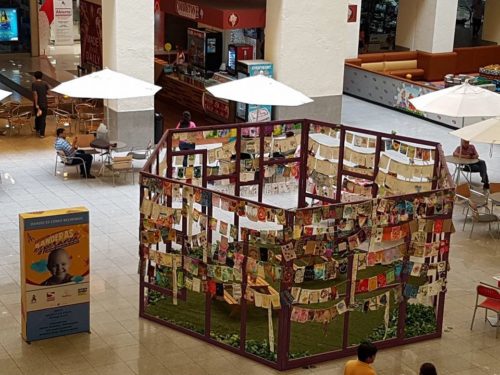
2017 Updated list of Exhibitions and Events
• August 19, 2017, exhibition at UC San Diego Centers for Integrative Health Launch & Celebration at Sanford Consortium, La Jolla, CA, USA
• August 11, 12 & 13, 2017, hosted by Roxana Orellana de Perez of ‘Sendas para la Mujer’ in San Salvador, El Salvador, doubled as a fundraiser to support cancer patients’ access to care.
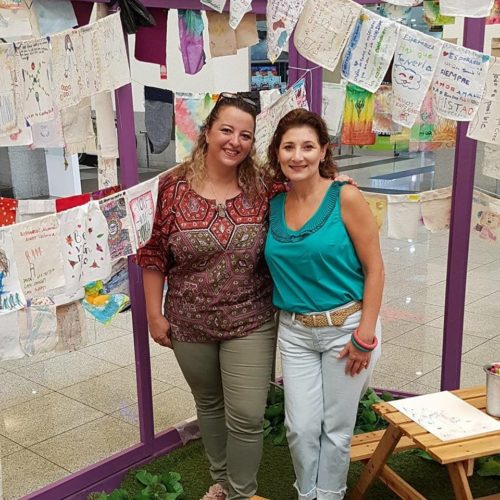
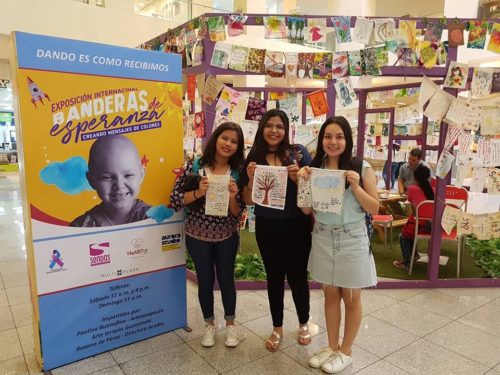
• July 7th – 9th, 2017, Guatemala City, Restaurante Porcino Pollo, Coordinated by Paulina Buonafina, Guatemala
• June 17th – 18th, 2017, The first Relay for Life in Switzerland
• November 4th, 2016, Consciousness and Healing Initiative (CHI) Summit, Paradise Point Hotel, San Diego, CA – USA
• October 30th – November 3rd, 2016, Academy of Integrative Health & Medicine 2016 AIHM Annual Conference: People, Planet, Purpose, Paradise Point Hotel, San Diego, CA – USA
• July & August, 2016, Oceanside Public Library, Oceanside, CA – USA
• June 25th, 2016, On the railing of the Neckarmüllerei, during the anniversary action day “Ich zieh´ den Hut” in support of women after cancer, on the Neckar Bridge, Germany
• March 3rd – 5th, 2016, APOS Conference, Sheraton Hotel, San Diego, CA – USA
• May 2nd – June 30th, 2015, Le Néné, Seestrasse 63, Stuttgart, Germany
• April 23rd – 25th, 2015, Exhibition at REHAB Conference, Karlsruhe, Germany
• January 14th – March 25th, 2015, Front Porch Gallery, Carlsbad, CA – USA
• October 20 – November 21st, 2014, City of Hope, Los Angeles, CA – USA
• August 14th – September 17th, 2014, Heritage of the Americas Museum, El Cajon, CA – USA
Contacts
-Europe:
Gabriele Heyd Engelfriedshalde 24 D-72076 Tübingen, Deutschland – gheyd@freenet.de
-South America:
Paulina Buonafina – Arteterapia, Guatemala City, Guatemala – info@arteterapiaguatemala.com.gt
The Role of Chinese Medicine in Integrative Oncology
By Kim Taylor, DAOM, L.Ac.
According to Global Cancer Statistics, 1.6 million people will be diagnosed with cancer in 2017. With improved detection and treatment, more and more people are now living longer with cancer. However patients are still affected by the distressing and debilitating side effects of conventional cancer therapies, such as surgery, chemotherapy and radiation. Patients seeking a more integrative and holistic approach to their cancer treatment are encouraged to build a comprehensive healing team drawing from both conventional and ancient wisdoms, in order to manage the side effects of treatment. Ultimately this should be a collaborative effort between the oncologist, a practitioner of acupuncture and herbal medicine, nutritionist, support group, and perhaps an energy therapy, such as Reiki, Qi Gong, or oncology massage. The result is a more synergistic therapeutic effect.
Chinese Medicine is a medical system dating back more than 2,000 years and is practiced by about one-fifth of the world’s population. It consists of many therapeutic methods including acupuncture, herbs, diet therapy, massage and exercise. Conventional Western cancer therapies have been used in China since the 1960’s, and around the same time the Chinese government began to fund research into traditional herbal medicines. While acupuncture has gained the most recognition in the United States, in China, traditional herbal medicine plays a far greater role in the Chinese health care system. With centuries of empirical evidence, China’s huge pharmacopeia contains thousands of substances, many that have scientific basis for their reputed health claims. One result is the use of Fu Zhen therapy, which is a regimen of herbal therapy used as an adjunct to chemotherapy and radiation, to protect the immune system, manage side effects and increase survival rates. These herbs have been shown to increase immunity by increasing T-cell function.
A few cautions should be considered, however, before taking herbs and/or supplements during cancer treatment. Many oncologists in the United States will advise against this, for several reasons. 1) The potential for herb-drug interactions: Many chemotherapy drugs enter the liver and convert to an active form. Many herbs also enter the liver and convert to an active form. There is an undeniable risk of an herb-drug interaction in the liver that could either down regulate, or potentiate the chemotherapeutic effect. 2) Even without an herb-drug interaction, the liver may become overloaded, if it must process chemotherapy, opiates and other prescription drugs, as well as process herbs and supplements, possibly leading to elevated liver enzymes and inflammation that could limit treatment. 3) Hormone positive breast cancers: The most common type of breast cancers are hormone positive, meaning that exposure mainly to circulating estrogen triggers malignant cell growth. Treatment aims to limit exposure to circulating estrogens as much as possible. The research is unclear if phyto-estrogens, the “natural” estrogens found in herbs and supplements, offer a protective mechanism against malignancy, or if they cause the same proliferation as circulating estrogens. 4) Herbs and supplements are often considered “anti-oxidant”, meaning they allegedly protect the cells from harmful free radicals linked to cancers. However, several nutritional trials have shown no obvious effectiveness in preventing cancer or in lengthening survival, and some trials suggest they actually may interfere with chemotherapy and radiation, because some of these treatments actually rely on increasing oxidation within cancer cells. Noble laureate James Watson, PhD, has a new hypothesis on reactive oxygen that he describes as his “most important work since the double helix.” He proposes that antioxidant levels within cancer cells are a problem and are responsible for resistance to treatment, and that the un-treatability of late-stage cancer may be the result of it having too many antioxidants.
In this current setting of confusion and emerging research, it is recommended to be conservative and informed when navigating these choices and treatment options. Patients are advised to seek consult from a Chinese medicine practitioner who is experienced in both herbal medicine, and in their understanding of oncology, so that the patient is informed of all concerns and can then make an educated decision that resonates with their own healing. Chinese herbal formulas are sophisticated in their construction, consisting of many herbs working synergistically together. Patients should never self-prescribe single herbs. A practitioner that understands oncology and is willing to collaborate with an oncologist will be able to construct a complementary treatment plan that can be administered safely with concurrent cancer treatments.
Acupuncture is another Chinese therapeutic method for changing the flow, or quality, of the life force and balancing the body energies. The Chinese believe that life force or “chi” flows within fourteen major meridians or energy channels, that traverse the body from the top of the head to the tips of the fingers and toes. Each meridian is connected to an internal organ, and specific points on each invisible channel, when stimulated, affect the flow of chi in the channels or in the associated organs. By stimulating these points with extremely fine needles, acupuncture unblocks energy or adjusts its flow. These concepts can be hard to grasp for Western thinkers, but with current understanding of the nervous system and neuroplasticity, we now know that the layout of the meridians mirrors the central and peripheral nervous system, and many common points are located very near to prominent nerve beds. The brain is signaled when the needle is positioned and responds by increasing blood cell counts and various other immune system elements, and by activating neurotransmitters. These messenger molecules are responsible for sending information to all cells of the body. Endorphins and enkephalins are well known neurotransmitters that stop pain and increase a feeling of well-being. Researchers are continually exploring exactly how acupuncture aids the immune system, but we now know that certain blood counts and immune enhancing chemicals stay elevated for at least 3 days following an acupuncture treatment. Acupuncture is a relatively well accepted adjunctive cancer treatment in the United States, because it has no risk of interfering biologically with chemotherapy and radiation, and it has very few side effects. Most comprehensive cancer centers in the United States have an acupuncturist on staff. Acupuncture can be used in the following areas during cancer treatment, to manage symptoms, promote relaxation, and increase survival and quality of life:
Pain Management: Acupuncture can be very effective for managing pain related to tumors, surgery, chemotherapy, radiation and inflammation. Cancer itself can be painful and the treatments for cancer can cause pain, swelling and inflammation. Pain medications have a host of side effects, including constipation, nausea, and mental confusion. Patients who receive acupuncture may be able to use lower doses of pain medications.
Immune System Support: It is widely accepted that stress lowers immune function. Many cancers and cancer treatment also lower immune function, by suppressing bone marrow, the source of blood cells that make up the immune system. Acupuncture has been shown to increase blood cell production and enhance Natural Killer (NK) cells and lymphocytes, thus promoting increased immune response and decreased risk of infection.
Reducing Inflammation: Increased inflammation is part of cancer physiology. Surgery, chemotherapy and radiation also cause painful inflammation. Acupuncture reduces pain and swelling related to inflammation.
Nausea and Vomiting: Chemotherapy kills both cancer cells and healthy cells alike. Nausea and vomiting is a common side effect of chemotherapy, as healthy cells of the digestive tract become patchy and raw. Acupuncture has been shown to reduce the intensity and frequency of nausea and vomiting in patients receiving chemotherapy.
Dry, Painful Mouth and Throat: Cancer patients receiving radiation to the head and neck may experience pain and swelling in the mouth and throat, making it very difficult to swallow. Additionally they may suffer dry mouth and throat and dental problems from damage to the saliva glands. Acupuncture has been shown to increase saliva production, and decrease pain and swelling, allowing the patient to be able to swallow, eat and drink normally, protect the health of the teeth and gums, and reduce the incidence of infections.
Sleep: Cancer patients often have difficulty sleeping from medications, post-surgical discomfort, anxiety and depression, and physical pain. Acupuncture promotes healthy sleep and relaxation, allowing the patient to get the deep sleep and rest required for recovery and healing.
Hot Flashes: Many women undergoing hormonal treatment for breast cancer experience hot flashes and dryness that disrupts sleep and daily activities. Acupuncture has been shown to decrease the frequency and intensity of hot flashes. Although most of these studies were conducted on women breast cancer patients, men with prostate cancer also experience hot flashes during hormonal treatment, and also benefit from acupuncture.
Quality of Life: By managing the side effects of surgery, chemotherapy, radiation, and hormonal therapies, reducing pain and inflammation, improving sleep, supporting normal digestive function and reducing stress, acupuncture treatment can improve the quality of life of cancer patients.
Got chemo brain?
By Teri Polley-Michea MA, RN, CMT, HHP, RMT
New hope for patients with cognitive dysfunction related to chemotherapy treatment.
Do you feel like your brain is not firing on all cylinders? That you are functioning in a brain fog? Your thought process cloudy making you unsure of yourself and your abilities? The exact mechanism of how chemo brain develops is unknown, but it is felt that there is some type of disruption of communication within the brain. There are few if any treatments available for patients who have chemo brain. Medications have been tried without much success.
A new treatment for chemo brain is being investigated at the Medical Synchrony Center in San Diego called PrTMS. PrTMS stands for Personalized Repetitive Transcranial Magnetic Stimulation. It is non-invasive, painless, and well tolerated.
PrTMS is a brain stimulation technique that uses MRI technology. The machine that houses the magnet is small, portable, and quiet–unlike the MRI machine that most people are familiar with. Each treatment lasts approximately 20 minutes depending on what your doctor has prescribed. The treatment is based on the results of an electroencephalogram (EEG) which is done in the office, first as a baseline, during the course of the entire treatment and at the end to chart your progress. The EEG is painless, It consists of a cap like device that is placed on the head and connected to a computer to read your brain waves. No gels or electrodes needed!
PrTMS is a FDA approved therapy that has been used in the treatment of depression, PTSD, autism, stroke rehabilitation and post injury concussion syndrome. Only recently has its use been considered as an option for treatment of chemo brain. A literature search completed on Google scholar revealed the majority of research studies published reported the use of PrTMS for depression, psychiatric conditions, and post stroke therapy. Patients had varied responses but overall had improvement in overall quality of life, improvement in cognitive function, lessening of depression and improvement in physical abilities post stroke. Still in the infancy period of discovery of how this treatment can be used in other cognitive dysfunction related illnesses, there is need for future studies to examine this therapy in the patient population suffering from chemo brain.
On a personal note, I had the opportunity to experience this treatment for menopausal symptoms. Originally I wanted to try this treatment so I could share my experience with my oncology clients. I wasn’t aware how useful it would be in treating my menopause mental fog. I was amazed how I perceived the world and the clarity I experienced during my treatment. My vision was clearer and everything looked brighter. I was able to sleep better and felt an improvement in my overall quality of life. And I am not alone. In a small unpublished study done in San Diego with 16 women with chemo brain symptoms, demonstrated that they experienced similar changes. This has lead the Medical Synchrony Center in pursuing research, funding, and Institutional Review Board approval for a clinical trial.
If you would like more information on the benefits of this treatment, or are interested in finding out more about the clinical trial please contact the Medical Synchrony Center, 16918 Dove Canyon Road, STE 206, San Diego, CA 92127 directly at 858-924-1116.
Hacking Into Healing: The REAL Future of Medicine
By Dr. Shamini Jain
First appeared in the Huffington Post on 6/05/2015 | Updated Jun 05, 2016
Investigating the “Impossible”
About 40 years ago, a group of microbiologists, behavioral scientists, and medical doctors in laboratories from UCLA to Russia proposed, based on their carefully conducted, independent studies, a completely heretical idea: that the brain, immune, and hormonal systems were connected — and that emotions had a major influence on the body.
They were completely laughed at by the scientific and medical community. Some were denied tenure. They were sometimes shut out of university laboratories for their “psychological nonsense.”
Nevertheless, they persisted with the idea, and with their tenacity and vision, as well as years of careful research in the laboratory, founded the field that we now know as psychoneuroimmunology, or PNI.
Fortunately for us, these scientists persisted — and paved a path that has had tremendous impact on our understanding of health and medicine. Forty years later, the fact that the nervous system, the immune system, and the endocrine system are connected is now a given, and nearly every day we are reading about exciting developments in these fields, such as the contributions of the vagus nerve in immune and brain communication, and the recent paper in Nature reporting the existence of functional lymphatic vessels in the brain — something that again, was thought to be impossible. We’ve learned about the power of our own emotional states on our immunity — and how our mental state plays a role in certain disease risks — in some cases, even helping predict how long we live.
Hacking the Body Electric
In parallel with these advances in PNI, we are seeing a rise in bioelectromagnetic medicine — including brain stimulation. These new devices — based on the mapping of the body’s responses to magnetic and electrical stimulation — are being heralded as the “Future of Medicine“ — and some show tremendous promise in helping forward better treatment of certain diseases.
Unfortunately, the devices that could mitigate diseases, can also serve to disempower us, if used improperly. The fervor for these devices doesn’t just stop at finding new solutions for cancer or Alzheimer’s disease — corporate interests are pushing the development of devices down to “fixing” our mood and even our eating patterns. Feeling sad or out of sorts, or need to obliterate that hunger craving? No problem, a brain zap can fix that. There are plenty of folks ready to sell you such devices, whether or not they actually are based on sound scientific evidence. Some people are also creating DIY brain stimulation devices for home use to treat depression and enhance attention, which is not safe.
Is the “New Medicine” really based on Ancient Medicine?
While industry focuses on devices that can be sold as the next new medicine, some scientists have been uncovering the effects of ancient medicine — mind-body-spirit practices such as yoga, meditation, tai-chi and even energy healing on psychological, neural, immune, and endocrine outcomes for patients including those with PTSD, cancer, and cardiovascular disease.
The interesting thing is that the health impact of these practices, which have been part of global cultures for thousands of years, were mapped out long ago by the sages that had discovered and shared them. The described “mechanism of action” circulated around the understanding that these are spiritual practices that have a strong influence on the subtle energy system (part of what we now call in the West the “Biofield”), and through refining ourselves spiritually, positive shifts occur in our emotional, mental and physical well-being.
Sadly, because of the emphasis on materialism in science and medicine, “spirit” is still considered a dirty word and is generally taboo for research and discussion. The study of “biofield” is not so far behind in the ridicule line, despite the basic science and clinical research demonstrating effects of the biofield on health, as is now being shown with bioelectronic medicine. In fact, industry is now in a race to begin mapping out the electromagnetic readouts of the body — one aspect of the biofield — but only to develop devices that can be bought and sold for mitigating disease symptoms.
The Future of Medicine is Up to Us
However, similar to the collaborations and dedication that resulted in the new field and advances of psychoneuroimmunology, a group of scientists as well as practitioners in diverse disciplines (including physics, biophysics, microbiology, psychology, endocrinology, technology, medicine, contemplative practice and the healing arts), are joining together to collectively advance the totality of understanding on the role of the consciousness in healing, including mapping the impact of mind-body-spirit practices on the biofield and health. This group of scientists, practitioners, and educators, who are part of the Consciousness and Healing Initiative, are ready to take the bold steps needed to rigorously ask and answer the harder questions — what is the role of our own consciousness in influencing our biology? How deeply can we guide and facilitate our own healing through our emotions, behavior, social, and spiritual connections, and how can we harness these effects to promote better health for ourselves, our communities and our planet? Scientific research that examines us as the agents of change for our own healing, would help to herald a true shift in the practice of medicine.
With these new advances in science, we have a choice to shape the new paradigm in health and medicine. We can choose to watch as industry dollars utilize scientific advances to advance the next wave of Big Pharma, or we can choose to support research that will irrefutably map the impact of our consciousness on our own health, so that we can better directly heal ourselves and prevent disease before it starts. We must choose not to lose the psyche in psychoneuroimmunology, and support the research and education that will truly empower our own health and healing, to usher in the real Future of Medicine.
Follow Dr. Shamini Jain on Twitter: www.twitter.com/ShaminiJain
About Shamini
Back to the top.
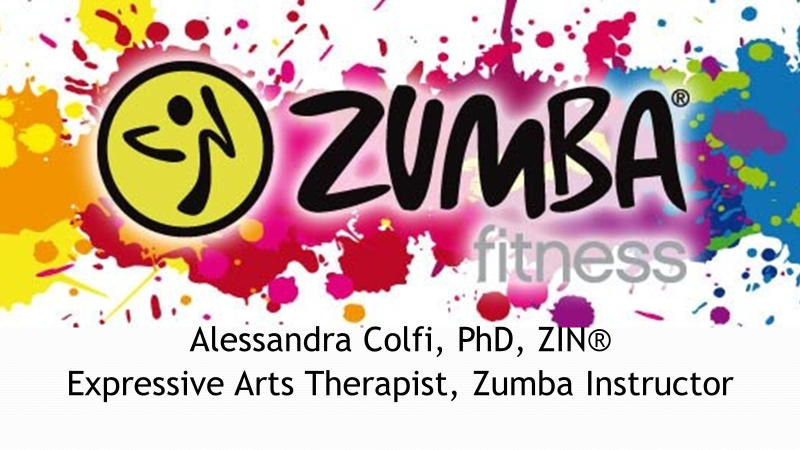 GENTLE DANCE FITNESS / EXPRESSIVE MOVEMENT CLASS
GENTLE DANCE FITNESS / EXPRESSIVE MOVEMENT CLASS
FOR CANCER PATIENTS, SURVIVORS & CAREGIVERS
Ph.: 858.735.5708 Alessandra@AlessandraColfi.com
Zumba® is a very popular form of aerobic dance exercise using contemporary music from all over the world with emphasis on Latin, African, Middle-Eastern, Pop, Hip-Hop, and Bollywood. Zumba® is recognized by the American College of Sports Medicine and the Aerobics and Fitness Association of America.
Many beginners and older adults find market-based Zumba® classes intimidating; too fast, too strenuous and too difficult to follow. Specifically, Zumba® dance routines are not suitable for cancer patients and survivors who often experience pain, limited mobility, post-op & recovery issues, fatigue, treatment side effects, self-image issues, weight gain or loss, lack of motivation, and decreased mental and physical energy.
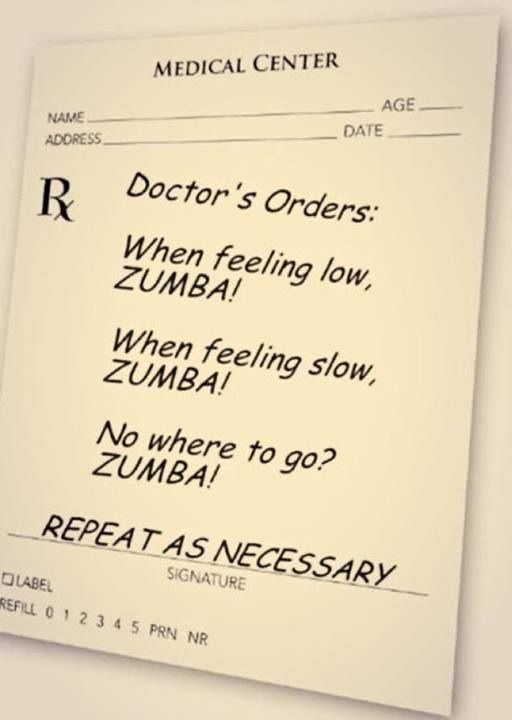
And yet exercise is critical to recovery and prevention: “Based on observational findings physical activity is the lifestyle factor most strongly and consistently associated with both cancer incidence and cancer recurrence.” ~ Robert J. Morgan, MD, FACP – City of Hope, Department of Medical Oncology and Therapeutics Research, Feb 15, 2016.
Since the joy of movement in a group is one of the highlights in Zumba® classes, participants are motivated to exercise playfully. Research shows that movement provides a wide range of benefits: it reduces physical and mental fatigue; increases blood flow and oxygen intake; awakens and enlivens body, mind and spirit; increases range of motion, balance, coordination and focus; facilitates sleep; increases body awareness, and might help individuals affected by depression and isolation – all assisting in lowering risk of recurrence and improving quality of life.
An important consideration goes to our lymphatic system, which needs to be aided through modalities like exercise, dance, massage: “A vital structure to the human body, the lymphatic system is a complex and important part of the immune system that helps maintain fluid balance within our tissues. Acting as a filter, it pushes lymph (fluid that contains white blood cells, oxygen, and other nutrients) throughout the smallest branches of blood vessels and washes the body’s cells. This destroys old or abnormal cells, such as cancer cells, and fights bacteria and infections.” Dana-Farber blog Insight, 2016 http://blog.dana-farber.org/insight/2016/09/what-is-the-lymphatic-system-infographic/
Another very important physiological aspect to be considered: studies show that inflammatory response to cancer treatments elevate levels of Cytokines which induce depressive symptoms. The American Cancer Society states that 25% or 1/4 of all cancer patients suffers from depression or distress, which has been found to decrease survival rates. (Candace Pert, PhD)
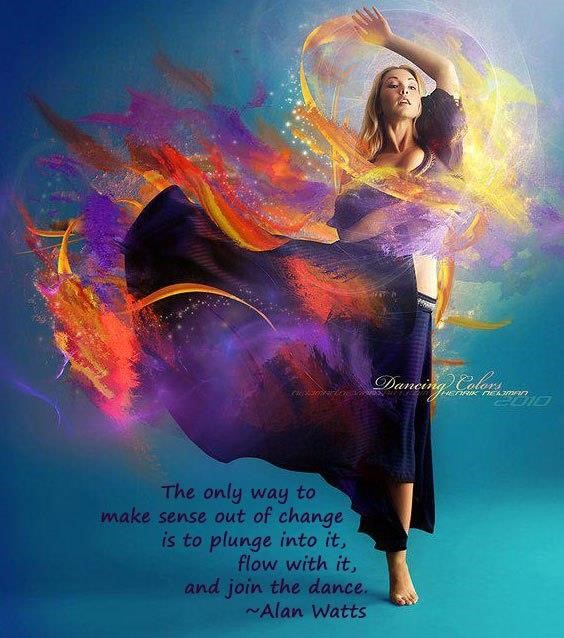 Studies show that dancing creates new pathways in the brain, improve depression symptoms, elevates mood, and fosters a positive outlook, while lessening the impact of ‘brain fog’ and decreasing risk of developing dementia later in life.
Studies show that dancing creates new pathways in the brain, improve depression symptoms, elevates mood, and fosters a positive outlook, while lessening the impact of ‘brain fog’ and decreasing risk of developing dementia later in life.
Dancing offers powerful symbolism for coping with the changes that a cancer diagnosis and treatments bring to a person’s life, to family and friends, and impact his or her quality of life – not to mention the beneficial effects of spontaneous laughter shared among your peers!
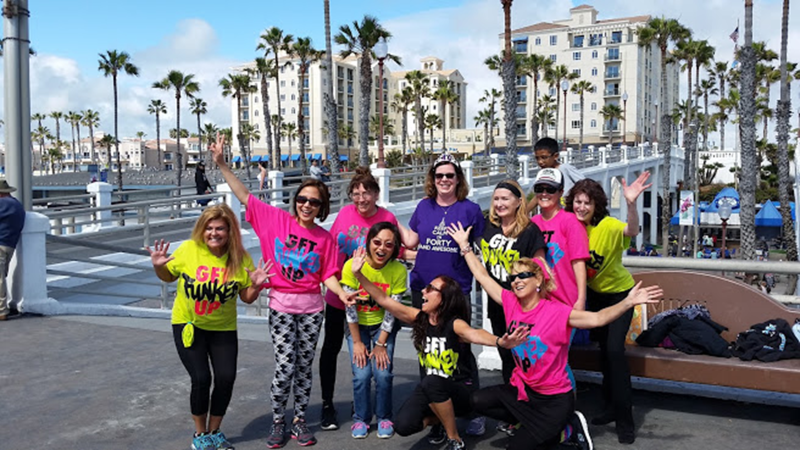 Zumba® Flash Mob ‘Uptown Funk’ at Oceanside Pier to celebrate a special birthday.
Zumba® Flash Mob ‘Uptown Funk’ at Oceanside Pier to celebrate a special birthday.
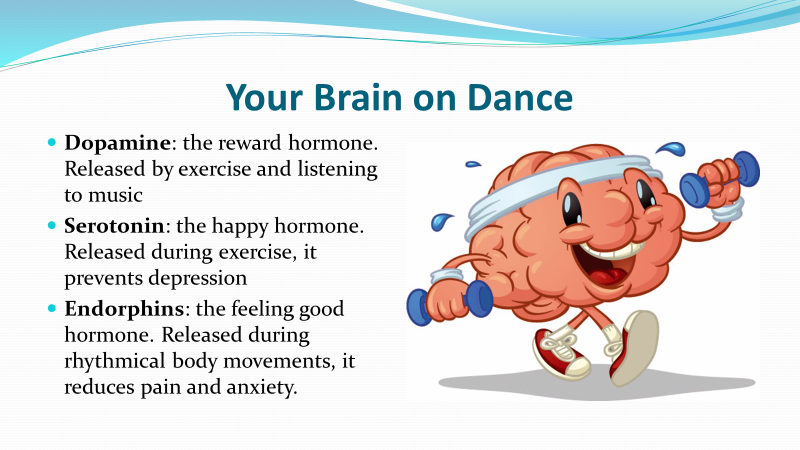
Why a special exercise class for cancer patients? Typically, participants in any Zumba® class are not given step-by-step instruction: rather they try to copy the instructor’s moves (which is difficult to do in large, crowded classes) and to follow the dance routines in a sort of “sink-or-swim” scenario. This might lead to injuries or it might be discouraging for someone with any kind of limitation. Zumba Gold® classes for older adults use slower-paced music, which doesn’t provide enough energy, engagement and the playful motivation that popular, high-energy dance tunes do.
A 2015 study conducted at the University of California found that while exercise is perceived by many as “boring, stressful, painful, [and] lonely,” Zumba is described as “fun, stress free, holistic, [and] socially supportive.”
Studies on Dance/Movement Therapy (DMT) effects on cancer recovery are still very limited; one recent study published in the Journal of Pain and Symptom Management states:
“DMT showed significant effects on buffering the deterioration in perceived stress, pain severity, and pain interference…The DMT program can counter the anticipated worsening of stress and pain in women with breast cancer during radiotherapy.” (Ho RT, Fong TC, Cheung IK, Yip PS, Luk MY, 2016) “…findings reinforced the benefits of DMT while adding the new perspective that delivering DMT intervention throughout cancer treatment can have different and even additional benefits for patients.” (Ho RT, Lo PH, Luk MY, 2016)
Studies show that healthy weight, regular exercise, and less alcohol could cut incidence by one-third. “Exercise needs to be a lifestyle…” (Dana Farber Beyond Cancer Podcast, 2016)
I’ve been using dance/movement therapy with cancer patients and survivors for 5 years, since Expressive Arts Therapy is an integrated multi-arts approach in which all art modalities – dance/movement, visual art, music, writing, sound, and drama – are woven into the exploration and therapeutic process as appropriate to each individual’s situation. “Dance movement therapy (DMT) is premised on an interconnected body and mind. It has known benefits for cancer patients’ physical and psychological health and quality of life.” (Ho RT, Lo PH, Luk MY, 2016)
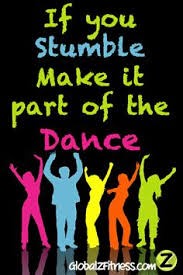 I design each Zumba® routine with our patients and survivors in mind and often incorporate their suggestions & preferences; simple dance movements to low, medium to high energy music that are conducive respectively to warm-up at the beginning and cool down at the end, balance, flexibility, muscle toning, and to practice focus and coordination through learning simple dance steps, addressing specific areas of the body and abilities – with the brain benefiting as well from focusing and learning new steps; high-energy music has the effect of stimulating participants to move; free-form dancing according to each individual’s preference, cultural background and style is encouraged as well. Zumba® is suitable for beginners at any age and is adapted to each participant’s ability and limitations, even while sitting on a chair.
I design each Zumba® routine with our patients and survivors in mind and often incorporate their suggestions & preferences; simple dance movements to low, medium to high energy music that are conducive respectively to warm-up at the beginning and cool down at the end, balance, flexibility, muscle toning, and to practice focus and coordination through learning simple dance steps, addressing specific areas of the body and abilities – with the brain benefiting as well from focusing and learning new steps; high-energy music has the effect of stimulating participants to move; free-form dancing according to each individual’s preference, cultural background and style is encouraged as well. Zumba® is suitable for beginners at any age and is adapted to each participant’s ability and limitations, even while sitting on a chair.

Here is a link to some of our dance choreographies: https://www.youtube.com/results?search_query=alessandra+colfi+zumba
TESTIMONIALS FROM PATIENTS CURRENTLY ATTENDING ALESSANDRA’S ZUMBA®
We all know exercise is good for us, but can it be fun too? My name is Joyce, I am a cancer survivor and volunteer for NCCF. I have two left feet and coordination is not my strong suit. Never, never, never thought I’d find myself in a Zumba class but at the urging of others there I was last week @ Frog’s … in Zumba … right where I didn’t want to be. An hour later with a huge smile on my face, heart pumping, feet tapping, and endorphins at an all time high, I answered my own question, “Yes, most definitely exercise can be fun too!
So, if you are looking to move your body, increase your heart rate and smile for an entire hour, you’ll be at Alessandra’s Zumba class this week! ~ Joyce, Encinitas, CA
You want a fabulous instructor, great cardio, stamina builder, mood enhancer, and laughter? Alessandra’s Zumba class is where you go! ~ D.S., Encinitas, CA
I think the Zumba is so good for so many reasons! Just when I thought I had body awareness, this brings such a new challenge! The incorporation of so much right/brain left/brain movements is so great for the nerve myelination and the movement and shaking of the lymph is so valuable. Thank you for bringing it to us!!
~ Justine Shelton, E-RYT 500
AVI Certified Viniyoga Therapist
Co-Director, Yoga Vista Academy
You are a dynamite instructor, Alessandra.
We are ALL blessed to have you helping us attain physical and mental strengths.
Thank you ever so much. ~ C. M., Encinitas, CA
Thank you for today’s Zumba. It was not only fun but really good for me! ~ J.L., Vista, CA
How can you not smile after a class like that?! Thank you! ~ D.P., Carlsbad, CA
How can you possibly know just how much your dance & exercise class has changed my life?…All I can tell you is that your energy, your dancing joy, your music and your radiance has a been a gift to me. I feel like a different woman. My health is better now that it has been in decades. Thank you so much for opening your heart, sharing your gifts and your passions. You are an angel to me (and to others), and I am forever grateful and charmed by your magic
~ C.A., Encinitas
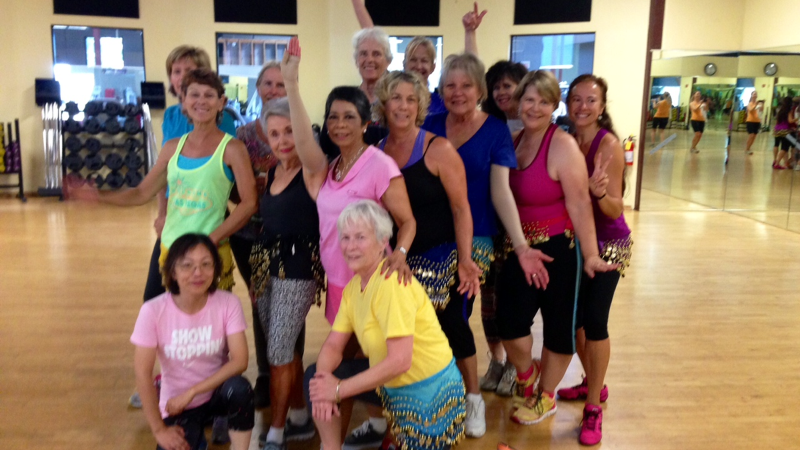
Our late Deb Snyder, visionary founder of North County Cancer Fitness with our great Zumba® group at Fitness Evolution, Encinitas.
Alessandra Colfi, PhD, ZIN®, Expressive Arts Therapist, Certified Zumba® Instructor, has been leading Dance/Movement Therapy sessions and Zumba® classes for cancer patients, survivors and caregivers through San Diego Cancer Research Institute at Yoga Vista and Fitness Evolution in Encinitas. Since SDCRI ended services to patients as of December 2014, she is offering weekly Zumba® classes through Yoga Branch Vista Village in Vista, North County Cancer Fitness at Fitness Evolution in Encinitas, and UC San Diego Moores Cancer Center.
She attended Master Classes with Dance/Movement Therapist Daria Halprin as well as Certified Zumba® Instructors. JourneyDance, Neuro-Muscular Integration Activity or NIA, 5Rythm and dancing regularly with a Cuban Salsa dance group make her embrace exercise/movement that is fun and encouraging as part of healthy lifestyle and one of the keys to self-care and social connections. Offering a modified version of Zumba® to encourage individuals affected by cancer to enjoy moving and reconnecting with their bodies, and to benefit from exercising in safety and with a group of peers is the highlight of her service.
More about Alessandra
A special note of gratitude to Sherry Zak-Morris owner of Yoga Vista until 2016, and Fitness Evolution Encinitas, for gifting the space to hold free classes for cancer recovery to the community.
Zumba® Classes:
UC San Diego Moores Cancer Center monthly calendar – free Zumba class on Wednesdays: https://health.ucsd.edu/specialties/cancer/about/Documents/PFSScurrentcalendar.pdf
North County Cancer Fitness: www.NorthCountyCancerFitness.org Zumba on Wednesdays. Fill out intake form to register before any class – free.
Yoga Branch Vista Village: https://clients.mindbodyonline.com/classic/mainclass drop-in Friday or Sunday Zumba® class $ 5.
References:
Exercise and Cancer. Dana Farber Beyond Cancer Podcast, 2016
http://blog.dana-farber.org/insight/2016/08/beyond-cancer-podcast-episode-4-exercise-and-cancer/
A Good Time to Dance? A Mixed-Methods Approach of the Effects of Dance Movement Therapy for Breast Cancer Patients During and After Radiotherapy. US National Library of Medicine @ NIH – PubMed.gov https://www.ncbi.nlm.nih.gov/pubmed/25730591
Exercise to prevent depression. Dr. Andrew Weil, Weekly Bulletin.
http://www.drweil.com/weekly-bulletin/exercise-to-prevent-depression/
Exercise Shows Benefits for Metastatic Colorectal Cancer Patients, Dana-Farber blog, Insight, 2017
http://blog.dana-farber.org/insight/2017/02/exercise-shows-benefits-for-metastatic-colorectal-cancer-patients/
Study Confirms Dance Fitness Improves Quality of Life. Zumba® Zlife®, 2016
http://zlife.zumba.com/study-confirms-dance-fitness-improves-quality-life/
Research shows that women view Zumba workouts as better than exercise. Medical Express, 2015
https://medicalxpress.com/news/2015-12-women-view-zumba-workouts.html
Can ‘Prehabilitation’ Benefit Cancer Patients? Dana Farber, 2017
http://blog.dana-farber.org/insight/2017/01/can-prehabilitation-benefit-cancer-patients/
Back to the top.
Managing Side Effects of Stress, Cancer & Chronic Pain With the Innovative Mindful Yoga Works Program
By Kitty Blincoe
When diagnosed with cancer life is never the same for the person who is diagnosed, nor for the people around them. Cancer experts agree a cancer diagnosis effects people differently than other disease diagnosis. Post diagnosis, cancer patients must learn to cope with emotional distress, solve cancer-related problems, and gain control over cancer-related life events. Moments of crisis and challenge can include hearing the diagnosis, receiving treatment, completing treatment, hearing that the cancer is in remission, hearing that the cancer has come back, dealing with medical bills, and becoming a cancer survivor. “The National Coalition for Cancer Survivorship (NCCS) pioneered the definition of survivor as being any person diagnosed with cancer, from the time of initial diagnosis until his or her death.” Managing the side effects of stress, cancer and chronic pain is a key mission for the survivor, as well as care givers, in order to find their “new normal” as quickly as possible so they may stay involved in activities and responsibilities that are meaningful and important to them and which affect their overall quality of life. Mindful Yoga Works combines yoga, meditation and group discussion and is an innovative, evidenced-based program developed at Duke University Medical Center for anyone wanting to learn useful tools for coping with stress amidst daily life.
As reported on CNN, USA Today and Business Week, the Mindful Yoga Works (formerly “Yoga of Awareness”) course has been through five clinical trials to date and participants in the program experienced a decrease in pain, improved sleep, vigor and relaxation. These five research studies have demonstrated important benefits of Mindful Yoga in medical populations in the form of an 8-week course “Yoga of Awareness”. The first two studies involved breast cancer patients at Duke University Medical Center, and three more recent trials focused on fibromyalgia patients at Oregon Health & Science University.
Mindful Yoga Works is a pioneering program focused on the journey of how we live with stress – from noticing how it physiologically impacts our body, our mind and even those around us, to learning to skillfully work through it. This course conveys essential elements of the ancient tradition of yoga – including meditation, breath work, postures, self-study and group sharing – in a context that is informed by modern, evidence-based medicine. The result is a powerful and transformative healing experience for an individual that reflects both the heart of yoga and the understanding of integrative medicine. Mindful Yoga Works has been shown in research studies at Duke Medical Center to help cancer patients at early stages as well as advanced stages of the cancer experience.
Clinical trials of this program demonstrated in the participant:
• significant decreases in pain, fatigue, insomnia, negative mood and hot flashes
• as well as increases in vigor, acceptance and relaxation
Important topics such as mind/body stress reactivity, and the value of awareness and skillful action in the midst of one’s daily life are covered. During the course participants are encouraged to practice yoga at home guided by audio and video recordings and illustrated handouts. Mindful Yoga Works is appropriate for anyone who is mobile and who wants to learn tools for coping with stress amidst daily life – whether managing chronic pain, “Type A personality”, sleep apnea, insomnia, illness such as cancer or fibromyalgia, or any other possible life challenge that may be difficult to accept and embrace.
Mindful Yoga Works combines yoga, meditation and group discussion; no prior yoga or meditation experience necessary. The founders of Mindful Yoga Works write,
Living skillfully in this way depends on mindful awareness. Mindfulness is the key to doing anything well in life, whether it be working, playing, talking, or eating.
In Mindful Yoga we learn to connect more fully with our inner resources – our deep down goodness and wholeness – as well as our daily life circumstances, so that we can experience greater well being and less suffering.
As a complement to ongoing medical treatments, Mindful Yoga may help with a variety of symptoms by promoting a sense of soothing bodily relaxation, refreshed vitality, and a greater ability to tolerate symptoms. For people who are feeling well physically but otherwise facing challenges, Mindful Yoga can assist in relieving general stress, and for dealing with issues such as how to maintain healthy relationships
This course incorporates experience gained by teachers with extensive training in traditional schools of yoga. Each class includes instruction and practice of:
gentle physical stretching exercises
meditation techniques
breathing exercises
Teachers adapt the yoga exercises and instructions during the course to individual needs and limitations.
In order to be a certified Mindful Yoga Works teacher, one must attend the training which is intermittently offered at Duke Integrative Medicine Center and Oregon Health & Science University. The Mindful Yoga Works teacher training explores:
• Evidence-based modules for cancer-related symptoms
• Tailoring asana and pranayama to specific symptoms
• Principles of Mindful Yoga
• Contexting yogic principles for people from various faith traditions
• Effective and clear ways of presenting models of stress
• Appropriate guidance for working with the mind
• Partnering with the medical community
• Group facilitation skills
Additionally, the founders write “For this course to have meaning and vitality, the leaders delivering it must do their best to embody the practice of Mindful Yoga in their daily lives. This will allow for them to lead from their personal experience and wisdom, rather than in a cookbook fashion. A person may be certified as a Mindful Yoga teacher if she or he: (a) has an established meditation practice, as defined by Criterion 1 – Meditation Practicum; (b) has demonstrable group facilitation skills and experience, including (but not limited to) completion of Criterion 2 – Presentation Skills Practicum; (c) is a registered hatha yoga teacher with ample experience working with special populations, as defined by Criteria 3-4 – Registered Yoga Teacher who has experience teaching yoga postures including specialized populations; and (d) Mindful Yoga Teacher Training Level 1 (formerly Yoga of Awareness Teacher Training Level I) course, and in most cases a Mindful Yoga Teacher Training Level 2 course; and (e) after fulfilling all the above requirements, has offered an initial Mindful Yoga course free-of-charge to a group of individuals, and recordings of the course sessions have been reviewed by Jim and/or Kimberly Carson. The Mindful Yoga course must be based on the 8-session Yoga of Awareness Program.”
The 8-week mind/body program was developed by Jim Carson, PhD and Kimberly Carson, MPH, ERYT at Duke University Medical Center. Here in San Diego, the Mindful Yoga Works course is led by Kitty Blincoe. Kitty Blincoe is currently the only certified Mindful Yoga Works teacher in Southern California, one of eight certified Mindful Yoga Works teachers nationwide and is the founder of Sanctuary Z – a recently opened private and semi private sleep, stretch and stress management treatment space near Carlsbad Village. http://www.sanctuaryz.com/
The VITA Program
By Jennifer Dawes Moore
It is tax time, not a favorite thing for most people, except those geeks that love to prepare them. I am defiantly one of those geeks. Last year I had the enjoyable experience of working with the Encinitas Community Resource Center (CRC) to prepare taxes for free. Why would they do that? Well the CRC is one of thousands of sites across the country that do this every year. This IRS sponsored program called VITA (Volunteer Income Tax Assistance) prepared more than 3.7 million returns at nearly 12,000 sites last year, and all free of charge.
This program is set up to assist low to moderate-income families and individuals. All Volunteers receive training and pass an IRS certification test. Some volunteers are accounting students or retired tax preparer and some are just people looking for another way to help their communities. Most volunteer return year after year, like me!
Who is eligible to get tax assistance? Anyone with low to moderate income who did not have rental income from properties you own, did not file for bankruptcy last year, and did not have self-employment expenses above $10,000.
Where can you find a VITA site? The Community Resources Center has appointments at its main office 650 Second St, Encinitas on Wednesday from 1-6 and Saturday from 9-5. They also offer preparation at sites in Oceanside, Vista and San Marcos though out the week. Appointments can be made by calling the CRC at 760-753-8300, calling 211 or online at myfreetaxes.org.
What to bring with you to the appointment.
• Photo ID for you and your spouse
• Social security card or ITIN for you and any dependents
• Income documents (W2 or 1099)
• Bank Account information for direct deposit (voided check)
• School tuition or student loan interest statements
• Mortgage interest statements
• Dependent care
And what if you are a tax geek like me, and would like to help out. I would love to hear from you. You can serve in a variety of roles, greeters, translators and tax preparers. No experience is needed, you will receive free training and materials.
For more information or question about filing or volunteering email Jmoore@crcncc.org
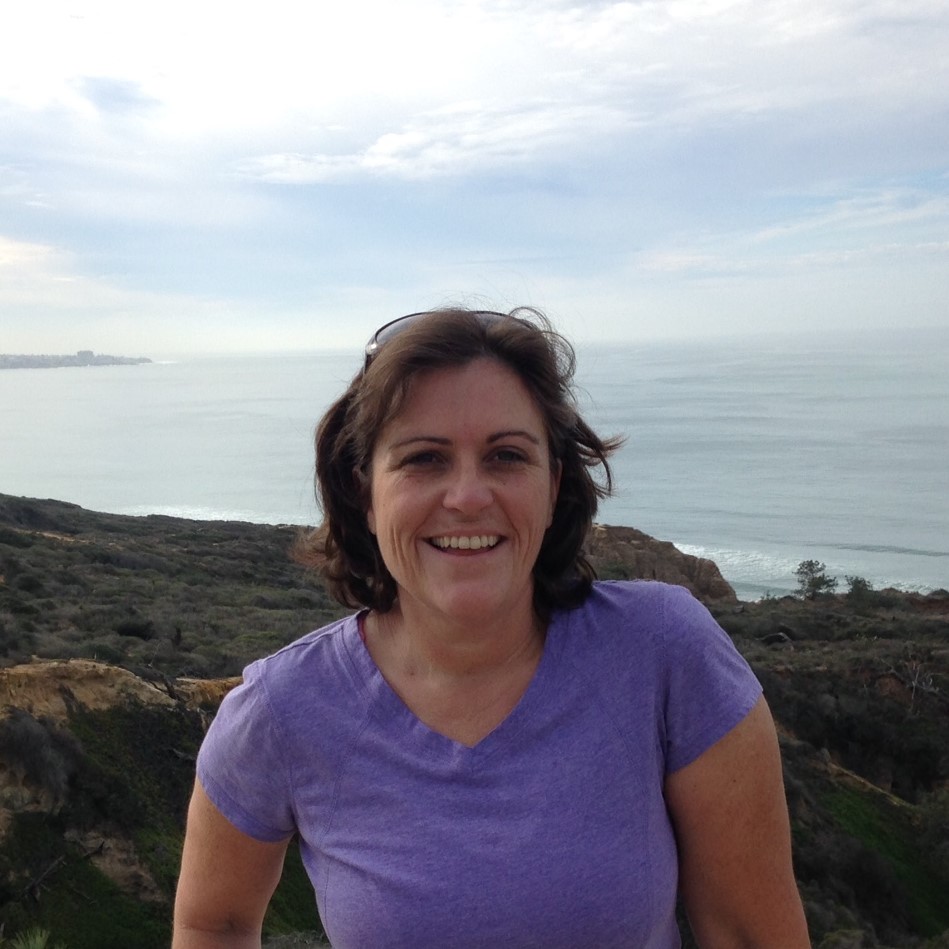
Back to the top.
SDCRI Review 2016
By Dan Vicario, M.D.
As a medical oncologist, I’ve had the privilege of working with a large number of cancer patients since 1987. I’ve been on an inspirational journey where I’ve learned so much from my patients and their loved ones that I feel the need to share some of that knowledge from now on. Having been medical director of two cancer centers for almost two decades and being part of a community that created an integrative oncology program back in 1995, I am now able to take some time off to reflect on the many things I’ve learned. This learning came from many teachers: cancer patients and their caregivers, nurses, colleagues, cancer center staff and practitioners of the many different healing arts.
Our San Diego Cancer Research Institute (SDCRI) is a nonprofit organization created in the year 2000 with two divisions: Genomic Oncology, directed by my business partner and dear friend Dr. Mark J. Adler, and Integrative Oncology which will be discussed here.
The integrative program started offering free complementary services in 1995 at the San Diego Cancer Center thanks to the generosity of several successful practitioners of the different healing arts who offered their time and skills as volunteers servicing the community of cancer patients. This program started at the San Diego Cancer Center in Vista and Encinitas with the intention of offering cancer patients the option of experiencing complementary healing modalities that were proven to improve their quality of life. It was open to all cancer patients in the San Diego community. This program was extremely successful, offering services to over 150 cancer patients every month with an average of 100 visits per week. At one point there were 50 active volunteers enrolled in the program. During its last ten years, the program’s coordinator was Mary Hollander, RN. Without Mary’s support and guidance we could not have reached everything the program was able to accomplish. Unfortunately, for the several reasons mentioned in previous news articles on this web site, the SDCRI’s free integrative services facility in Encinitas had to close in December 2014.
The good news is that the San Diego Cancer Research Institute remains active in its mission of education, collaboration and research. Since the closing of the free integrative services facility in Encinitas, SDCRI has continued its education and research collaborative efforts with several other institutions and has remained an active web-based resource. The Integrative program team will continue to update the webpage with news, Integrative and Genomic Research updates, Nutrition and Oncology updates, Dr. Paul Brenner’s videos, the latest info on the Hope Made Visible Project directed by Dr. Alessandra Colfi, educational programs and more. Mary Hollander and Juli Shelton continue to help with SDCRI’s Integrative program and update the website on a regular basis. SDCRI will continue to expand in 2017, continuing its online nutrition program: Reality Based Nutrition by Mary Hollander RN, Dr. Paul Brenner’s Blog, SDCRI’s integrative oncology projects, collaborative research and educational videos.
SDCRI’s Integrative Oncology program continues to collaborate in various broad based Integrative Research projects. We are working to continue to expand research on the importance of embracing proven integrative healing modalities to support cancer patients. Research projects include the fields of nutrition, exercise, yoga, mind body practices, massage, psychoneuroimmunology, acupuncture, bio-field therapies, art therapy, aromatherapy, and others.
We also have the pleasure of collaborating with practitioners, professionals and researchers in naturopathic medicine, homeopathic medicine, and ancient healing traditions like Ayurveda, Chinese medicine, and Indigenous medicine.
Current SDCRI’s collaborations include:
-U.C. San Diego Cancer Services Encinitas and Vista
-UCSD Center for Integrative Medicine (CIM): http://cim.ucsd.edu/
-UCSD Center of Excellence for Research and Training in Integrative Health (CERTIH)
http://fmph.ucsd.edu/integrative-health/coe/index.html
-Chopra Center and Chopra Foundation: https://www.choprafoundation.org/
-Consciousness and Healing Initiative (CHI): http://www.chi.is/
-Guarneri Integrative Health: http://pacificpearllajolla.com/guarneri-integrative-health/
-Miraglo Foundation: http://www.miraglofoundation.org/
-Scripps Center for Integrative Medicine
-University of California, Los Angeles (UCLA)
-University of California, San Francisco (UCSF)
-Institute Of Noetic Sciences (IONS): http://www.noetic.org/
-Resolution Care: Dr. Michael Fratkin and Team: http://www.resolutioncare.com
-Dr. Bob Uslander: http://www.drbobuslander.com/
-
-
- At a recent SDCRI board meeting, the following updates were discussed:
Research protocol collaboration between SDCRI, UCSD, Chopra Foundation, UCSF: “I-CAN”: Initiative for Cancer Survivorship Approached Naturally. For this research project, patients who are breast cancer survivors will attend the “Perfect Health” healing program at the Chopra Center, La Costa resort. Several markers of healing and quality of life will be measured before and after the 6 day retreat. This research protocol has been approved by the UCSD Investigational Review Board (IRB). - The San Diego Cancer Research Institute, Dr. Dan Vicario and SDCRI’s Integrative Program have partnered with the “Consciousness and Healing Initiative (CHI)” to support its purpose, projects, research and service. CHI is an international collaborative accelerator of scientists, health practitioners, innovators, educators, researchers, professionals, artists, individuals and nonprofit institutions who share CHI’s vision. For details on the “Consciousness and Healing Initiative (CHI)” please go to this link: http://www.chi.is
At this time, SDCRI offers CHI administrative support and is also its fiscal sponsor until CHI becomes its own separate nonprofit entity. - SDCRI continues collaborating with UCSD Center of Excellence for Research and Training in Integrative Health (CERTIH) and Center for Integrative Medicine.
- Paul Brenner, M.D., Ph.D. continues with his educational videos and working on research in Epigenetics and his “Family Triangles” method.
- Mary Hollander R.N. continues with her outstanding online nutrition program: “Reality Based Nutrition”, filled with inspiration and wisdom.
- Alessandra Colfi, Ph.D., continues to expand the International Hope Made Visible™ (HMV) project: creating and sharing artful flags among cancer patients, survivors, families/friends, and caregivers. This project has created over 1,200 flags, from all over the USA, Canada, Colombia, Argentina, Guatemala, Ghana, France, Germany, The Netherlands, Italy, and Australia. These flags have been sent for exhibitions in Europe and throughout our communities for display in several venues. Hope Made Visible™ has also collaborated with Habitat for Humanity’s Veterans Program.
- The SDCRI Integrative Volunteers will meet again for its annual “SDCRI Integrative Medicine Volunteer Appreciation Dinner”. They will again be thanked and reminded of how grateful SDCRI and the community are for their outstanding care and service. The volunteers continue to express their gratitude for the experience they had working with cancer patients over the last 15 years.
- Dr. Vicario continues to be a Faculty speaker at the Chopra center educational program “Journey into Healing”, which takes place twice a year.
- SDCRI has organized collaborative meetings between Dr. Ralph Greenspan, co-creator of the “Brain Initiative”, Dr. Paul Mills from UCSD CERTIH and Dr. Paul Brenner.
- SDCRI has obtained three trademarks: “San Diego Cancer Research Institute”, “Hope Made Visible” and “The Promise of Research, The Science of Healing”.
- At a recent SDCRI board meeting, the following updates were discussed:
-
The Integrative program volunteers and the San Diego community continued to be an integral part of SDCRI’s growth in 2016. The SDCRI board remains deeply grateful for all this support and looks forward to its continued growth in 2017.
Daniel Vicario, M.D.
December 2016
